- BOAT OF THE YEAR
- Newsletters
- Sailboat Reviews
- Boating Safety
- Sails and Rigging
- Maintenance
- Sailing Totem
- Sailor & Galley
- Living Aboard
- Destinations
- Gear & Electronics
- Charter Resources
- Ultimate Boating Giveaway


Sailing Across The Atlantic In A Catamaran
- By Sheryl and Paul Shard
- Updated: June 13, 2018
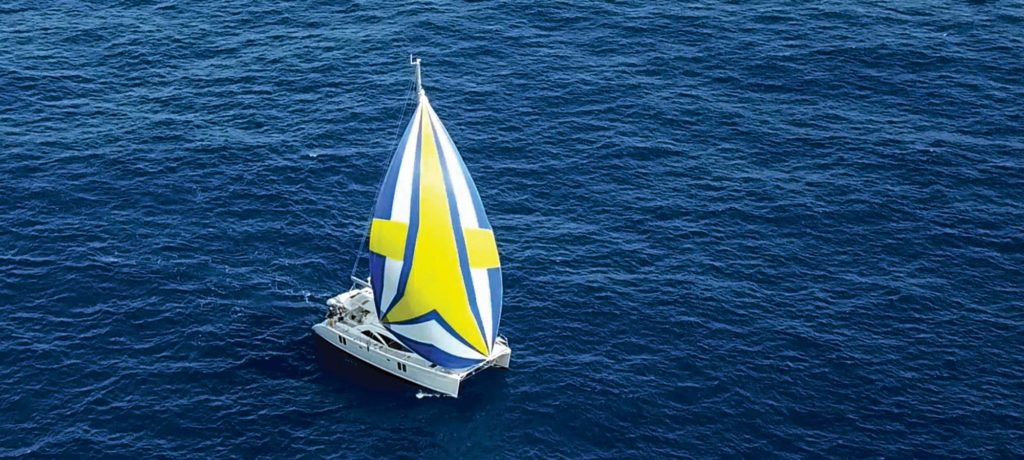
Monohull or multihull? Have you ever gone back and forth pondering the pros and cons of cruising on each? We certainly have, so when my husband, Paul, and I were given the chance to deliver a brand-new Bluewater 50 catamaran across the Atlantic from Las Palmas, Gran Canaria, in the Canary Islands to St. Lucia in the Caribbean last winter, we jumped at the chance. Paul and I have been cruising and living aboard since 1989 and have sailed more than 100,000 nautical miles on the four boats we’ve owned over our nearly three decades of global voyage-making. The boats were all monohulls, but every time we bought a new one, we toyed with the idea of moving to a catamaran. Why? We discovered that we enjoy shallow-draft sailing, which most multihulls offer, as much as we love offshore passagemaking. For long-term living aboard, the space offered aboard most multihulls is certainly attractive. We were proud of our first boat, Two-Step, a Sparkman & Stephens design called the Classic 37, but after a while, we found her depth restrictive as we discovered how much we enjoyed gunkholing and navigating through small inland waterways. Cruising had become a lifestyle for us, and we wanted more space on board plus a few more comforts. Paul and I feel blessed since, as independent television producers and travel-documentary filmmakers, we are able to earn our living while sailing full time, but all the camera, audio and editing equipment we need to carry takes up a lot of storage space. We needed to expand.
The criteria for our next boat was a good shallow-draft design with safe and comfortable offshore capabilities, so multihulls were definitely under consideration. In the end, we stuck with what we knew and ended up choosing a monohull with a swing keel, a configuration that has suited us on our cruising journeys for many years.
Although we are now in the process of building our new boat, a Southerly 480, we continue to be intrigued by catamarans. Feeling out of sorts being “between boats,” we chartered a Voyage 50 catamaran in the British Virgin Islands to get a much-needed sailing fix in the tropics, and spent the time with friends aboard. It was a luxurious boat, with four en-suite cabins with queen berths, and was set up well for chartering, but we wondered what a catamaran this size would be like for serious ocean cruising. We were soon to find out.
Discovery Yachts builds several brands of high-quality cruising yachts, including Southerlys and Bluewater catamarans, and the company reached out to us with an opportunity to deliver a new Bluewater 50 called Zão (pronounced zay-oh by the owners) from the Canary Islands to the Caribbean, leaving Gran Canaria in early November. Zão ‘s owners, John and Caroline Charnley, highly experienced sailors and the newly retired former owners of Discovery Yachts, had family and business commitments until Christmas but wanted the boat moved to the Caribbean so they could enjoy a winter of island-hopping before going through the Panama Canal. They asked us if we would take the boat across to St. Lucia for them. Seeing this as a great chance to sail a purpose-built 50-foot offshore cruising catamaran to learn how it performed on an ocean passage in the many conditions we were sure to encounter on a 2,800-nautical-mile Atlantic crossing, we accepted the offer.
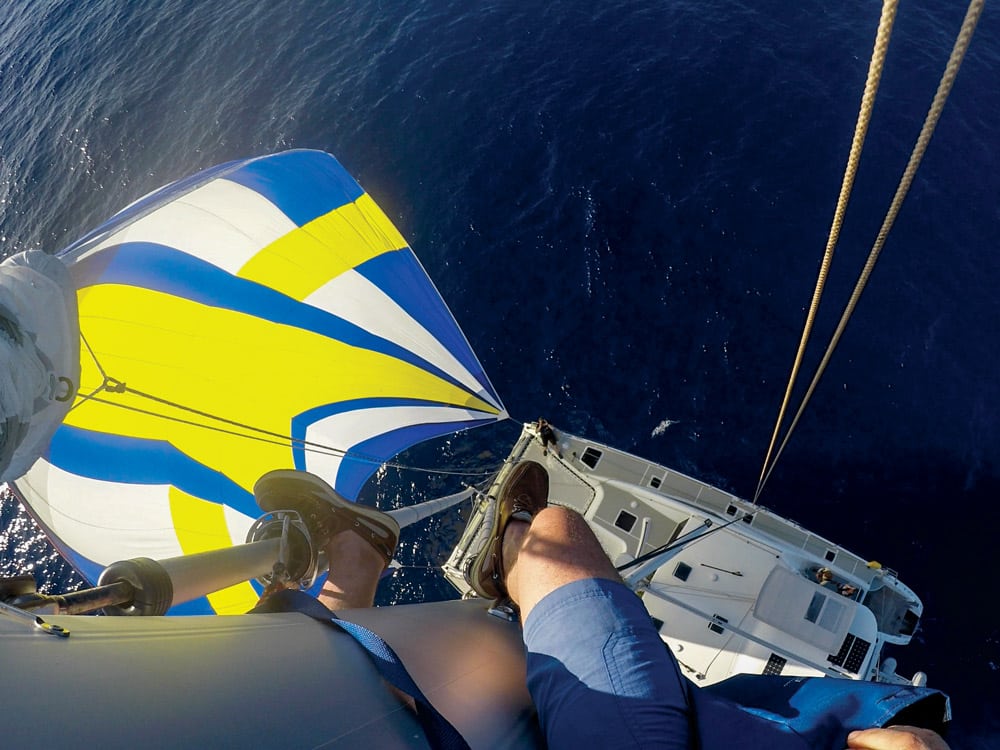
We flew to the Canary Islands the first week of November 2017 to meet up with John and his new Bluewater 50 in Las Palmas. Soon to join us would be four friends as crew, all fellow sailing bloggers and videographers — Alexandra Palcic and David MacDonald of Sailing Banyan ; Dan Krughoff, professional chef and videographer; and sailing vlogger and police officer Craig Bowman, of Cruising Off Duty . All were monohull sailors with some catamaran experience, mostly through chartering. Dave and Alexandra lived aboard their boat in the Caribbean, having sailed from Canada several years ago. Dan and Craig were each in the market for a catamaran for full-time voyaging.
November is a popular time to make the east-to-west crossing of the Atlantic Ocean because hurricane season is officially over and you arrive in the Caribbean in time for Christmas, a nice time to start a winter of exploring the islands. More than 200 boats participating in the Atlantic Rally for Cruisers were descending on the marina in Las Palmas to begin preparations for their ocean run to St. Lucia, as were many other independent non-ARC cruising boats and crews, so it was a crazy, busy, festive place at that time of the year. Las Palmas has one of the best marinas in the Canary Islands for sailors since every supplier and service needed for yachts preparing for an ocean crossing can be found there.
Seeing Zão at the dock when we arrived in Las Palmas was such a delight. Her long, swooping modern lines were a contrast to the more angular-shaped catamarans gathering in the marina. What a difference from the 50-foot cat we had chartered earlier, which, in fairness, was set up purely for vacationing. Zão was designed for long-term living aboard and long-haul passagemaking. This was the second Bluewater catamaran the Charnleys had built, so they had thought through every detail for comfortable living in their retirement but also set the boat up for serious adventure on their upcoming around-the-world voyage.
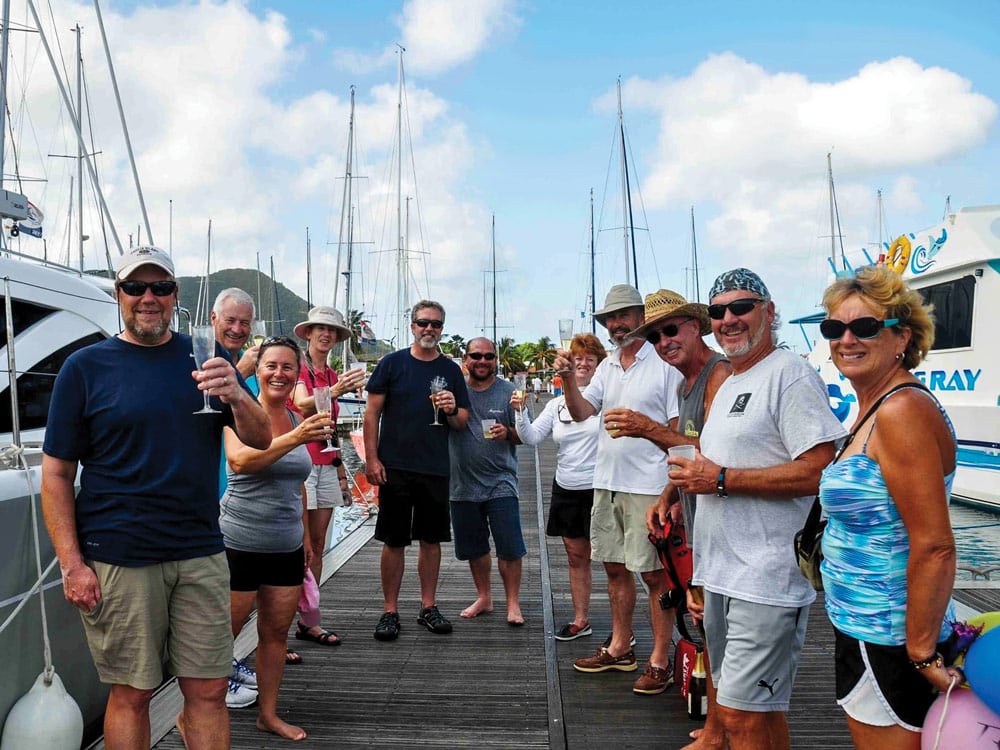
When Paul and I stepped on board, the first things we noticed were the fine table lamps and two free-standing lounge chairs in the main saloon, neither of which appeared to be bolted down. As monohull sailors, this made us nervous.
I asked John about how these were to be stowed offshore. He just smiled.
“You’re on a catamaran now. They will just sit here for the whole passage. You don’t have to stow things the way you do on a monohull,” he assured me. “You can even move the chairs around to watch the large-screen TV.” He continued to grin. This was going to be a very different passage compared to what we’re used to.
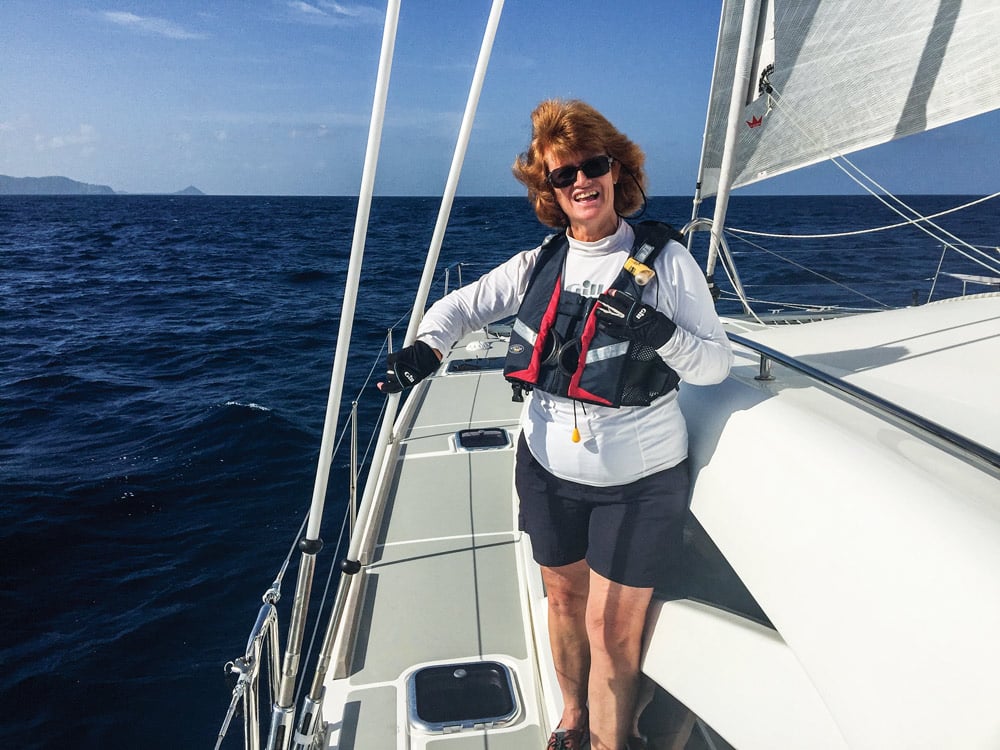
Paul and I had gotten somewhat comfortable with leaving things sitting on tables and countertops while sailing on the catamarans we had chartered in the past, but in the British Virgin Islands we were sailing in the comfortable confines of the protected Sir Francis Drake Channel, not on the open sea. John showed me how the chairs were positioned on the floor with mere strips of Velcro and how the heavy table lamps sitting around the main saloon and navigation station were sitting on nonskid mats. I still wasn’t convinced that once we got some serious waves at sea these things wouldn’t go flying.
The next thing I noticed, as one who loves to cook, was the expansive galley on the bridgedeck, with an all-around view and opening windows into the cockpit. There were large, easy-to-clean Corian countertops, including a peninsula countertop that you could work at from three sides. There would be six of us aboard, and although Alexandra, Dan and I would be sharing most of the meal preparations, everyone liked to cook and would be pitching in, so it was nice to see that there was space for all of us to work.
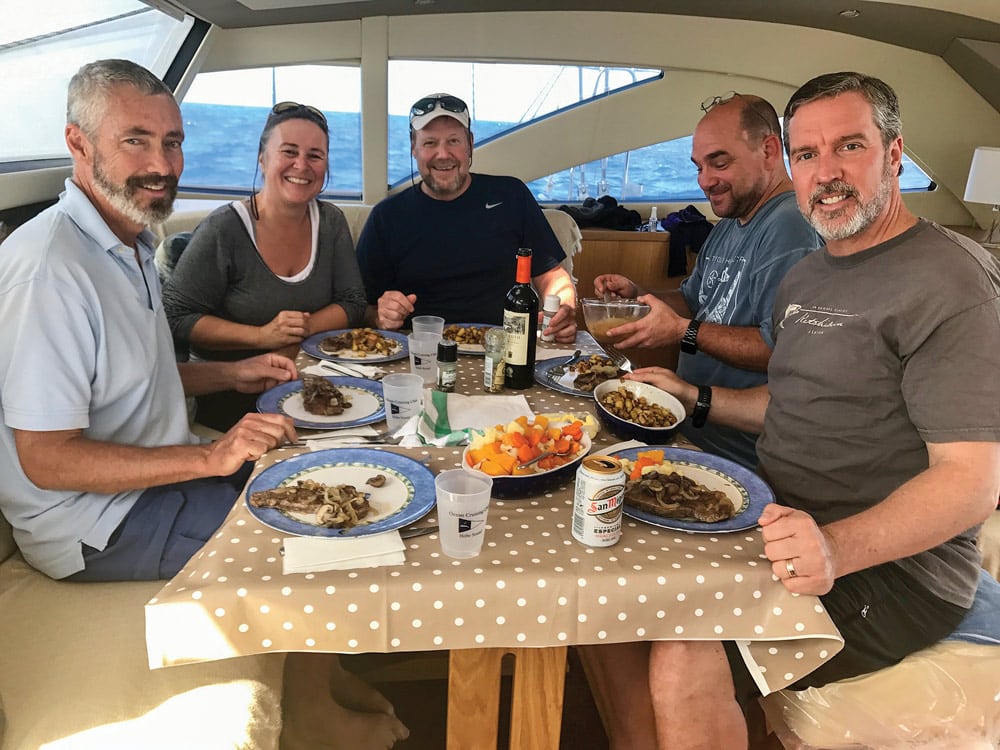
To add to our culinary creativity, there were a four-burner propane stove and oven, a microwave and a large front-opening fridge with two additional fridge/freezers in the owners hull to port. These had exterior temperature monitors and alarms. There were also numerous cupboards for storing supplies, so stowing our provisions was going to be a breeze!
Then Paul noticed a high-powered electric kettle.
“The electric kettle is just for port, right?” asked Paul.
“No, you can plug in this kettle anytime, even at sea,” John told us. “It’s the only one we’ve got or use.”
Paul looked skeptical, thinking of the power drain. Then John explained the electrical system — a hard Bimini the width of the cockpit, covered with solar panels; a 6 kW generator; and a large lithium battery bank. Right. The kettle wasn’t going to be a problem.
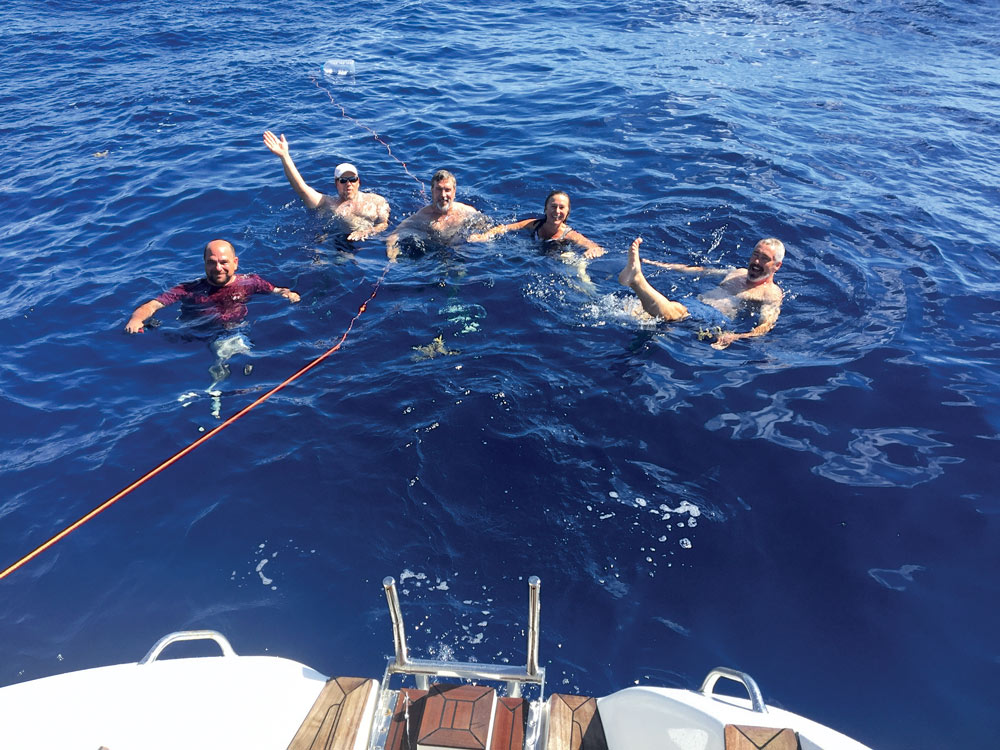
Paul and I made our home in the owners cabin, which featured a queen bunk aft and a head with separate shower and front-loading washer/dryer at the forward end. There were two other en-suite cabins on the starboard side. Dave and Alexandra took the queen berth aft. The forward cabin had a V-insert in the berth, which was removed to make twin bunks for Dan and Craig.
As soon as the crew was settled in, Alexandra and I began the mammoth job of provisioning for a crew of six people with help from Dan and Craig. Dave and Paul went over the boat’s systems with John, organizing repairs, doing maintenance and ensuring that everything was in good working order and that we understood the equipment before leaving for sea. Dan set up and tested our Iridium Go/PredictWind satellite and weather-routing system, and became our communications officer. Everyone pitched in whenever and wherever help was needed.
Alexandra is an impressive organizer and rearranged the contents of all the lockers for ease of access while we were underway, taking notes so we could return things to where John and Caroline had put them. She grouped all like items together, and put things close to where they would be used and where it would make the most efficient use of storage space. Then we started stowing bags and boxes, bottles and cans, long-life cartons of juices and milk, baskets of fresh produce, freezers full of frozen meat and shellfish, pizzas, berries and desserts. Since everyone on board was a foodie, this was not going to be a beans-on-toast cruise across the Atlantic!
This was our eighth transatlantic passage, and it turned out to be the lightest-wind Atlantic crossing we have ever made, with several days of total calm. Where were the trade winds?
Because we’re monohullers who don’t worry too much about weight on a boat, Zão was a bit heavy when we set sail from Las Palmas on November 12. An advantage, though, of a large cruising catamaran is that the boat can handle it, and as we were about to find out, we would be at sea for a lot longer than the two weeks we had planned on.
Fortunately, water usage wasn’t a concern either. Dave ran the generator twice a day during his and Alexandra’s 0800-to-1200 and 2000-to-2400 watch, and made plenty of water with the Dessalator watermaker at the same time. All six of us could have had two showers a day if we’d wanted to — and often did.
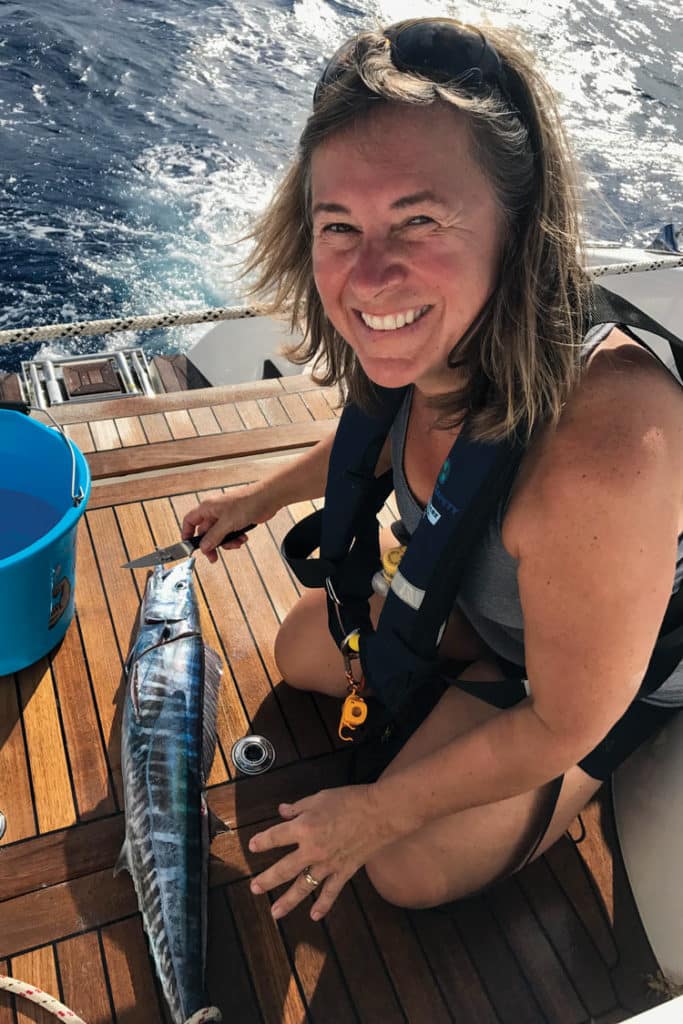
We had light but good breezes the first day out, which helped everyone get their sea legs and allowed us all to get used to the equipment on board and practice handling Zão ‘s sails. The boat has Elvstrøm Epex laminated sails, which hold their shape and work well with the Seldén in-mast furling system. It took us a few tries to get the hang of the furler, so we appreciated Craig’s instruction on how to use it. He has it on his boat. The trick is to maintain tension on the mainsail at all times while furling it. We came to love it and, as a result, we ordered the same for our new boat.
One of the things we didn’t like about the other catamarans we had sailed was the noise of the waves slapping the bridgedeck, which was loud and never rhythmic. It got on our nerves, so Paul and I were rather anxious about how we would handle this on a long passage. However, on the Bluewater 50, the hull shape was designed to counter this, and we found that startling wave slaps happened less often and weren’t as loud or bone-shaking when they occurred. Granted, we never got the big seas we had been hoping for to test out the boat.
This was our eighth transatlantic passage, and it turned out to be the lightest-wind Atlantic crossing we have ever made, with several days of total calm. Where were the trade winds? Like all the other boats around us (we were receiving position reports from the ARC and ARC+ fleets), we all ended up being at sea for at least an extra week longer than planned.
We checked the weather using PredictWind a couple of times a day, and there was nothing but days of extremely light wind or no wind at all in the forecasts. The Bluewater 50 is a fast cat and, thank goodness, handled the light airs well, but we never got the conditions to really put her through her paces.
We started by sailing wing-and-wing using two headsails but ended up flying the asymmetric spinnaker day and night, doing two-person watches around the clock just to keep the boat moving. We all got pretty good at sail trim. When the wind dropped, we doused the sail and, mid-Atlantic, had a swim 1,000 miles away from the closest land. We fished. We cooked. We ate. We slept. We celebrated Thanksgiving. Alexandra baked cakes. We read. We danced. There was lots of room. We chased birds off the deck, which must have mistook us for an island. We shouted with delight when dolphins came to play. Craig flew his drone. We saw amazing sunsets and shooting stars. We played cards, which included a three-week Wizard tournament. We watched TV. Had pizza-and-a-movie nights. We left our cameras and computers lying around. Were we on a boat? It was way too comfortable.
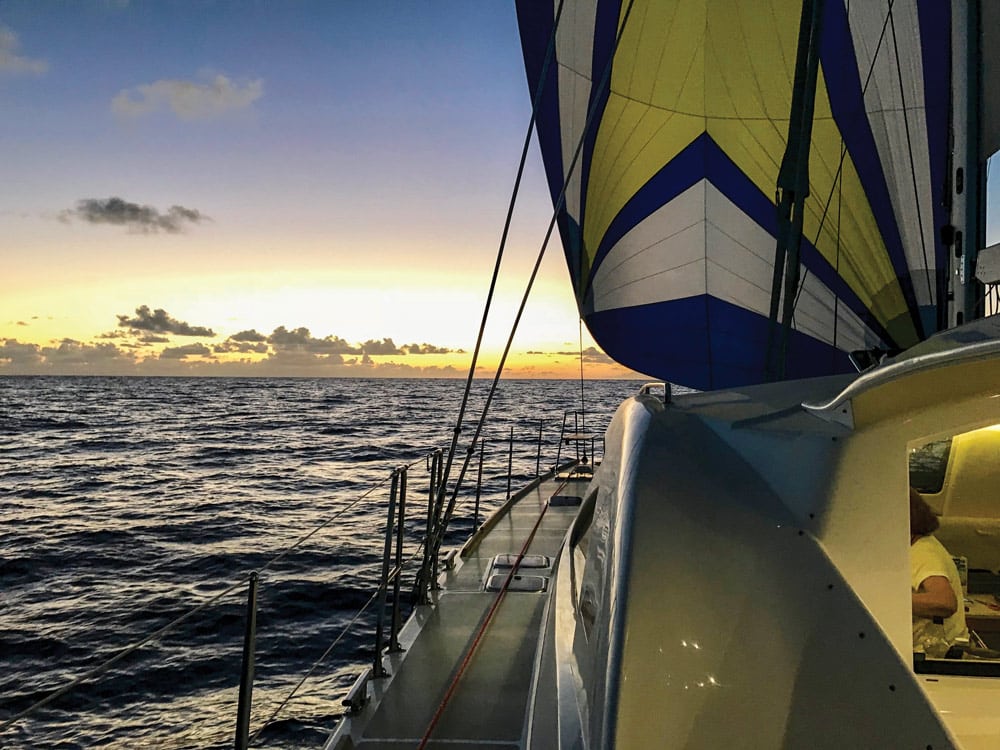
One thing I noticed about passagemaking on a multihull is that I had much more energy than when I go to sea on a monohull. Not being on a heel all the time means it doesn’t take as much physical effort to do simple tasks. Overall, everyone in the crew felt the same. We also dealt with tasks more readily since it didn’t take much effort to get up and deal with things.
Unfortunately, or fortunately, this applied to cooking. We were constantly preparing meals and feasting. No one lost weight as we usually do on a monohull passage, where you sometimes eat minimally since food prep and eating just feel like too much effort at times.
On December 3, 21 days and 3,000 nautical miles after setting sail from Las Palmas, Gran Canaria, we made landfall in St. Lucia. The boat felt enormous as we came into Rodney Bay Marina, but with the twin Yanmar 80 hp diesel engines, we could turn on a dime. Twin screws make even large multihulls easy to maneuver. We were greeted by the happy owners, John and Caroline.
So, have we become multihull converts? Well, we can definitely see the advantages now and understand why for some sailors they are a good choice for cruising. It all comes down to what works for each of us. After all, it’s love for being on the water that all cruising sailors share — be it on one hull or two.
Sheryl and Paul Shard have been living the cruising dream for nearly 30 years. Together they have traveled more than 100,000 miles under sail, including eight Atlantic crossings. Learn more about the Shards’ adventures and their TV series, Distant Shores, on their website .
- More: atlantic , bluewater sailing , canary islands , catamaran , discovery yachts , monohull , multihull , Sailboats , st lucia
- More Sailboats

Pre-Owned: 1988 Hylas 47

Catalina Introduces the 6 Series

Sailboat Preview: Elan GT6 Explorer

For Sale: 1984 Camper & Nicholsons 58

Galápagos: A Paradise Worth the Paperwork

Around Alone

Grease the Wheels of Your Boat: A Guide to Proper Lubrication

A Bowsprit Reborn: A DIY Renovation Story
- Digital Edition
- Customer Service
- Privacy Policy
- Terms of Use
- Email Newsletters
- Cruising World
- Sailing World
- Salt Water Sportsman
- Sport Fishing
- Wakeboarding

Can A Catamaran Cross The Atlantic Ocean? 7 PoInts To Consider Before Adventure!
- Post Written By: Boater Jer
- Published: July 19, 2022
- Updated: July 22, 2022

Disclaimer: You might notice that we recommend products in some articles. We may earn a commission for referring you if you click the link and buy a product.
We only recommend products we’ve tried/tested/own (that’s why you won’t find thousands of affiliate links on my site). If you have experience with one of the products we’ve mentioned, please share your experiences in the comments at the end.
Can A Catamaran Cross The Atlantic Ocean?
Catamarans come in many sizes and for different uses, from personal watercraft to yachts and even ferries. However, can a catamaran cross the Atlantic Ocean with those two hulls? That’s the question we intend to answer, and the results might surprise you!
Catamarans are suitable for long-distance travel due to several advantages in their design. Specifically, cruise catamarans are the best for great-distance travel, among other types, and these can cross the Atlantic Ocean.
Are Catamarans Good For Long-Distance Travel? Can A Catamaran Cross The Atlantic?
Catamarans are known for their two hulls and wide beam. This design induces stability, increased buoyancy, high speed, and motion comfort. Additionally, the wide beam ensures space in catamarans for food provisions and supplies storage suited for long-distance travel.
The high speed of catamarans can outrun storms, and their stability reduces the chances of the vessel capsizing. Interestingly, the Seacat Hoverspeed Great Britain catamaran performed a nearly three-day journey and was known to be the fastest sea crossing of the Atlantic in 1990. Hence, catamarans are reliable and safe for long-distance travel. ( source )
There are several advantages of catamarans used for long-distance travel, which are attributed below.
Catamarans tend to experience very little to no heeling, thereby allowing the ship to usually stay flat on the water when exposed to wavy sea conditions. Consequently, this allows the passengers and crew to accomplish activities and tasks commonly rather than uncomfortably at an angle. ( source )
The rolling (i.e., potential movement from side to side) of ships varies according to design. The more rolling a ship experiences, the higher the tendency of passengers to experience motion sickness. However, the double hull of catamarans often does not sway from side to side in a swell. ( source )
Stability And Comfort

Consequently, the little to no rolling of catamarans promote better sea comfort to passengers who often do not experience motion sickness . Additionally, a significant reduction in heeling and rolling factors causes catamaran vessels to have more stability. ( source )
Wide Living Space
The platform connecting the two hulls of catamarans provides more potential space for leisure and comfort to both passengers and crew. For example, open decks may be established for whale watching and fishing activities. Additionally, hammocks may be deployed for passengers to sunbathe. ( source )
Additionally, one may also build closed decks on catamaran platforms. For example, one can allocate more deck space to passenger cabins which can induce more privacy for family and friends while resting. ( source )
Shallow Draft
The double-hull configuration of catamarans allows them to have a wide beam and a lighter weight distribution. It enables catamarans to enter shallow water environments like coral reef areas. Passengers may then enjoy SCUBA diving, snorkeling, and swimming in such places. ( source )
Additionally, for convenience, you can do emergency maintenance (e.g., damaged hull) on beaches or other shallow areas.
Two Engines
The two hulls of catamarans can accommodate twin engines. Twin engines can induce more speed. Also, one engine failure would not compromise the movement and safety of a catamaran as one engine can still function. ( source )
Interestingly, twin engines can allow a catamaran to maneuver a 360-degree turn which is a tremendous advantage in close-spaced terminals/marinas.
Can A Catamaran Cross The Atlantic Ocean? Well, They Are Difficult To Sink, So…
Catamarans are challenging to sink due to the twin hull configuration keeping the vessel positively buoyant. Even if one hull is damaged, the remaining hull can keep the boat afloat. ( source )
Fuel Consumption
Catamarans can be designed as hybrids that enable these vessels to use solar, wind, and fuel energy generators for propulsion. Hence, catamarans tend to save more fuel than their monohull counterparts. ( source )
Environmentally Friendly
As catamarans can be hybrids, these vessels may alternatively use energy sources (i.e., solar, wind, and fuel) for propulsion. Therefore, these vessels are more eco-friendly during long-distance travel. ( source )
Types Of Catamaran
There are several types of catamarans for different purposes of sailing, such as:
- Racing catamarans
- Beach catamarans
- Cruising catamarans
The cruising catamaran is suitable for long-distance travel or anywhere around the world. This catamaran type can manage rough sea conditions and have particular perks more suited for the journey than the other types.
Cruising Catamaran Attributes
Cruising catamarans have the following attributes which make them suitable for long-distance travel:
- Positive buoyancy material
- Watertight hatches
- High-strength cockpit windows
- Redundant systems (e.g., bilge pumps, navigation lights, radios)
These attributes lead to a safer and more reliable long-distance sea-faring vessel. Additionally, these attributes are not available in racing and beach-type catamarans.
Can A Catamaran Cross The Atlantic Ocean? Let’s Talk Duration.
The duration of crossing the Atlantic by catamarans varies according to weather conditions, vessel speed, and route. The journey may take approximately 2-4 weeks with an average speed of 9-10 knots.
However, little or no wind support during several days may cause an extension for a few days in travel.
Hence, the best choice would be to allocate one month’s worth of food provisions and supplies to account for unfavorable weather conditions and the well-being of passengers and crew.
Route Planning
It would be best if you carefully plan routes to ensure safety. Modern technology can now easily map out the ideal route for the journey, especially if choosing routes to get to destination/s faster. Weather forecasts can also aid in which route to take or avoid.
Crossing The Atlantic In Winter
The enclosed and high-strength cockpit of catamarans protects them from winter and rainy weather elements. Hence, catamarans are safer to sail than monohulls during winter. Additionally, catamaran crews can operate their vessels from inside or outside enclosed cockpits, as with winches and sails, which can also be automated.
Catamaran Flooding
Catamarans have excellent compartments, with the cockpit high beyond the waterline. For example, one hull is damaged and needs to be fixed immediately. Yet, the boat is not entirely in danger of flooding as one hull can keep certain parts of the vessel afloat.
Hence, the cockpit could be challenging to be flooded from the hulls and is the main reason catamarans do not usually sink.
Catamaran Safety Equipment
Can a catamaran cross the Atlantic safely? The answer is yes, with the right-sized ship, the right crew, and the proper safety equipment. The vast deck space of catamarans allows for storage of high-tech contained life rafts and emergency supplies. This makes them ideal for such an adventure.
Catamaran Speed
The high-speed capability of catamarans also contributes to safety. For example, a catamaran can outrun rough weather conditions due to its high speed, which is potentially and simultaneously generated from twin engine power and wind (i.e., through the deployment of sails) energy. ( source )
Risk Of Injury
There is a high risk of injuries onboard catamarans, especially in rough weather conditions. Additionally, tools and equipment can be hazardous if encountered by accident. It is essential to ensure the storage of first aid medical kits and to address passenger/s and crew who may be injured during the journey. ( source )
Overall, catamaran attributes on heeling, rolling, stability and comfort, vast living space, privacy, shallow draft, two engines, hard to sink, fuel consumption, and eco-friendly potential allow these sea vessels to be well suited for long-distance travel, thereby fit for crossing the Atlantic Ocean.
Cruise catamarans are the most ideal for crossing the Atlantic Ocean. Additionally, essential considerations must be made on the following factors: route planning, crossing the Atlantic during winter, flooding, safety equipment, and speed.
- Related Articles
- Article Sources
Crab Island by Pontoon: A Fun Watery Boating Guide Destination in 2024
Crab island isn’t an island at all, but an underwater sandbar that’s become the Mecca of boat relaxing and watery good times. Learn more at www.Boating.Guide.
Upgrade Your Boating Experience: Adding a Third Pontoon Made Easy!
As the sun sets over the tranquil waters, the gentle hum of the engine and the soft lapping of waves against the hull create a symphony of serenity. Boating enthusiasts know there’s nothing like being out on the water, surrounded by nature’s beauty. But what if we told you you could take your boating experience…
How Long Does It Take A Canoe To Go… (Canoe Calculator Here)
You asked, and we answered: Here’s a calculator to determine how long your canoe trip will take. The calculator uses the average speed of an average canoe in calm water. Here it is: The Canoe Trip Time Calculator: Canoe Trip Calculator Enter the distance: Kilometers Miles Calculate Canoe Articles & Information replica rolex
- Fernandez, R.P. and Redondo, F.A.G. On the origin, foundational designs, and first manufacture of the modern catamaran. Internation Journal of Maritime History, NA (2022) NA. doi: https://doi.org/10.1177/08438714221075417 , Accessed July 16, 2022
- Luhulima, R.B., Setyawan, D. and Utama, IKAP Selecting monohull, catamaran, and trimaran as suitable passenger vessels based on stability and seakeeping criteria. The 14th International Ship Stability Workshop (ISSW), September 29 – October 1, 2014, Kuala Lumpur, Malaysia., Accessed July 16, 2022
- De Melo, G. and Echevarrieta, I. Improving the efficiency of a high-speed catamaran by replacing the propulsion system. The International Journal on Marine Navigation and Safety of Sea Transportation, NA, NA (2015) NA., Accessed July 16, 2022
- Deakin, B. An experimental evaluation of the stability criteria of the HSC code. International Conference on Fast Sea Transportation FAST 2005, June 2005, St. Petersburg, Russia., Accessed July 16, 2022
- Ferry, M., Wan Nik, W.B., Ahmad, M.F., Gasperz, F. and Manuputty, M. Comparative study of hybrid catamaran versus diesel monohull boat as a ferry for short distances routes. Indonesian Journal of Naval Architecture, Vol 1., No.1 (2013): NA., Accessed July 16, 2022
- Sunardi, Efani A., Oktiyas, M.L. Design of the eco-friendly shallow draft fishing vessel. Research Journal of Life Science, Vol. 2, No. 3 (2015): 199-204., Accessed July 17, 2022
- Dzan, W., Chang, S. and Hsu, K. Designing and building a catamaran and its stability analysis. 2nd International Conference on Robot, Vision and Signal Processing, 10-12 December 2013, Kitakyushu, Japan., Accessed July 17, 2022
- Santosa, P. The configuration of engine-sail catamaran fishing vessel. IOP Conference Series: Materials Science and Engineering, NA (2019) doi:10.1088/1757-899X/462/1/012008, Accessed July 17, 2022
- Luger, T.J., Peham, D., Mayr, B., Gromer, G., Raab, H. and Luger, M.F. Emergency preparedness and long-distance leisure catamaran sailing . Science & Sports, Vol. 26, No. 3 (2011): 174-178., Accessed July 17, 2022
replicarolex
Share this post with your friends, subscribe to our newsletter.
Join us in our love for all things water. And Adventure.

9 Common Reasons Boats Break Down So Much
Boats can break down for many reasons. The boat maybe out of gas or there is blown fuse. Let’s take a look at the most common reasons why a boat break down.

Are Bass Boats Good For Shallow Water?
As fishermen, we know the importance of being able to navigate your boat in shallow waters. After all, the shallows will present a lot of opportunities to make a nice catch. But it’s essential to know the limitations of your boat. If you get too engrossed in fighting the fish, you can quickly bring the vessel too close to the shore.

Rope Types Every Boater Should Know
Rope can come in a variety of sizes, colors, and types. It can be made from any fibrous, stringy, and obviously long-stranded materials. For boating, depending upon the purpose of the rope, there are a variety of different types that you will encounter.

Are Ranger Boats Worth The Money? (We Find Out)
Many people consider boats to be a luxury item, and some of the costs involved when buying a boat tend to support that paradigm. Ranger boats are a trendy brand in the Us boating fraternity, and they can sometimes demand a high price compared to other boats. Is the price for Ranger boats justified, and

How Long Can You Leave Gas In A Boat?
Gas is yet another essential item in a boat. Gasoline is essential for any combustion engine, whether it’s an outboard or an inboard. So, how long can you leave gas in a boat? Leaving gas in the boat can be dangerous. Luckily, there’s a specific time limit to which leaving gas in a boat is

When Is A Boat Called A Yacht? (Find Out Here – FAST)
When is a boat called a yacht? Let’s find out. The marine community interchangeably uses boats, ships, and yachts. Even though these watercraft mostly sound the same, there are distinct differences among the three. Boats can refer to watercraft ranging from personal vessels to something that can carry one or more passengers. Yachts sound more

Boat Information By Type
© 2023 Boating.Guide, A Hyperwave Media Group Ltd. Publication.
Privacy Overview
Yachting Monthly
- Digital edition

How to sail across the Atlantic and back
- Elaine Bunting
- March 8, 2021
Confined to quarters during the pandemic, many sailors are itching to slip their lines and sail for the sun. Elaine Bunting explains exactly how to break free and sail across the Atlantic and back

If your dream is sailing off into the sunset, making it a reality could be easier than you think
Just as the island of Hiddensee drew across the wake of the boat, Malin Andersson took up her camera and shot a video, writes Elaine Bunting .
When she looks at it now, a late summer scene from the Baltic coast of Germany, she remembers it as the instant she knew for certain she was right to think of leaving work to go cruising.
Malin and her partner Kaj Maass, both from Sweden and aged in their late twenties, met as students and formed a plan to take a year off before starting a family.
After years of scrimping, they bought a Bavaria 38 and renamed her Cross Ocean .
With the last tiny island of a summer cruise behind them, they began to prepare to sail across the Atlantic and back, and a year of adventure.
‘From then, we have never had a moment of regret about setting off,’ she says.
Each year, hundreds of yachtsmen of all ages sail across the Atlantic.
Some have only a few months of freedom, others plan to cruise indefinitely.
Their ambitions shape diverse choices in terms of boat design and preparations.
Here, we look at some of the biggest considerations if that is your goal, too.
What’s the right boat to sail across the Atlantic?
A good place to start might be with the question: can I sail across the Atlantic and back in the yacht I have now?
In most cases, the answer is yes.
Almost any well-prepared yacht of 30ft and upwards can tackle the downwind crossing, and indeed there is no reason why an even smaller boat can’t do it successfully.
People have crossed in Folkboats; the legendary American sailor Webb Chiles sailed across the Pacific in a converted 24ft dayboat, and some masochistic adventurers have crossed oceans in micro yachts not even long enough for them to stretch out in.
Two sailors I have repeatedly met over the years are Swedes Pekka and Barbro Karlsson.
They first crossed the Atlantic in 1986 in their 32ft Arvid Lauren-designed double-ender, Corona AQ .

Pekka and Barbo Karisson have sailed their 32ft double ender across the Atlantic multiple times over 30 years. Credit: World Cruising Club
Over the last 30 years, they have made multiple crossings back and forth, observing boats getting ever larger, even of the same LOA as theirs.
By comparison, theirs is dwarfed in every dimension, including beam and freeboard, yet it has everything this experienced couple need for living on board for six or more months every year.
So, really, it is a matter of cost, preference and expectation.
The big question is whether your current yacht is the best tool for the job given your budget.
Is it large enough for the crew you intend for longer passages, for the provisions, fuel and water?
A 35-footer might take 25-28 days to sail across the Atlantic from the Canaries to the West Indies.
Obviously, the longer and faster your boat is, the more stowage and water tankage you will have for less time at sea.
You might also ask yourself which parts of the adventure are the most valuable to you.

A solid yacht set up for bluewater cruising is a good option and can be sold once you return home. Credit: Tor Johnson
If you don’t intend to do the more arduous return home to Europe, maybe you don’t need a bigger, more expensive, more complex long-legged bluewater cruiser; you could consider shipping back – more on that option later.
If you intend to live on board for longer, then perhaps you will want more space, including for guests, greater comforts and faster passage times.
In that case, one solution might be to buy for the duration of the project a second-hand bluewater cruiser already well kitted out with the right gear, then sell her right afterwards.
‘I think that makes total sense,’ says Sue Grant, managing director of Berthon International, the well-known brokers specialising in bluewater cruisers.
‘The best thing you can do for a North Atlantic circuit is to buy from the guy who had the dream, had the money and didn’t go. A refit will always cost you more than you think.’
For a two- to three-season transocean cruise, Grant advocates stretching up to your next level, especially to a yacht that doesn’t need a big refit and brands with a strong residual value.
‘If you buy a high-quality Hallberg-Rassy or an Oyster then sell it you’d lose 10% of value but have three years for it.’
Buy a boat you will enjoy
While in the Azores in 2012 I met Stuart and Anne Letton, who were sailing their Island Packet 45, Time Bandit , back to the UK.
Their boat was brimming with sensible ideas for living aboard and I have kept in touch with them over the years as they are a wonderful source of thoughtful advice.
Since then they have sold the Island Packet , bought an Outremer 51 catamaran, sailed across the Atlantic again, and are presently in Indonesia having sailed across the Pacific.
In total, they have now logged a very impressive 60,000 miles.

Catamarans are increasingly popular thanks to their speed and space. Credit: Stuart & Anne Letton
‘Before we went cruising, I spent a lot of time looking at what would be the best, safest mode of transport. I wanted a proven, tough, sturdy, bombproof ocean cruiser, hence Time Bandit [the Island Packet], the “Beige Battleship”,’ says Stuart.
‘Having spent my sailing career racing performance dinghies and keel boats, this was something of a departure for me. It was safe. And a bit boring. However, the reality is you all end up in the same place, give or take a few days. With reflection, though, I’d say, buy a boat that will make you happy, one that reflects your sailing style and capabilities. We opted for slow but safe and used the safe features a handful of days in 10 years. Those were years we could have been enjoying more rewarding sailing.
‘Buy what you will enjoy, can afford and are able to keep running. Do the maths on running costs, rig, insurance and repairs, and work that into the budget.’
Asked about their ideas of the ideal size for a couple, the Lettons comment: ‘Generally I’d say bigger is better, but the costs are exponential. Personally, for two up, I think around 40-45ft feet is a good size: big enough to be safe and comfortable, small enough to manage.’
Tips on how to sail across the Atlantic from Stuart & Anne Letton
The couple own the Outremer 51, Time Bandit and have completed four Atlantic crossings and sailed 60,000 miles

Stuart and Anne Letton.
‘Being very well set up for dead downwind sailing is important, especially well thought-out preventers, fore and aft on the spinnaker pole and main boom.
‘An asymmetric or spinnaker will keep you moving in lighter air.
‘Save on gas with a Thermal Cookpot and get as much free power from water and sun as you can.
‘Trade in your trusty CQR or Bruce anchor for a spade or similar “new technology” anchor .
Is a bigger boat better for crossing the Atlantic?
Like the Lettons, I think 40-45ft is something of a sweet spot, offering the volume and tankage required for longer cruising, yet still manageable by a small crew.
Bigger has its advantages, even up to 55ft (above that the loads become too large to handle manually and maintenance is a massive chore for a family crew, requiring significant time and budget).
The waterline length and extra speed will be your friend, most of the time.
Speed is your ally in evading bad weather, and if you are sailing to a schedule.

The Witt family sailed around the world as part of the World Cruising Club World ARC
Karsten Witt and his wife, Sheila, circumnavigated in the World ARC in their X-55 Gunvør XL , and he says: ‘It was hardest work for the smaller or slower boats. They are at sea longer, therefore experience more and sometimes harder weather, arrive later in port, get more tired and have less time to make repairs and bank downtime.
‘I would always go for a modern boat that’s faster,’ he adds.
‘If you had a heavy 40ft cruiser you would miss weather windows. Other boats spend days battling headwinds because they were doing 6-7 knots upwind and they couldn’t point. We averaged 200 miles a day every day, so in five days were a long way away and in completely different weather.’
But you certainly don’t need a large or expensive yacht, just a well-prepared one.
Starting with the basics: safety gear, fire and gas installations, good sails with deep reefs, in date and inspected rig, winches and all machinery serviced, and power and battery systems upgraded if necessary, plus full inspection of keel fastenings and rudder, skeg and bearings.
After that, you really need to know how everything on board works, how you’d repair or service it and, if you can’t, how you would manage without.

Karsten and Sheila Witt and family enjoyed the extra pace and comfort of their X-55. Credit: World Cruising Club
Only after considering that is it worth adding complexity.
Multiple power generation systems, including hydro-generator and solar panels, watermakers, diesel generators and WiFi networks.
Mark Matthews is marine surveyor who ran Professional Yacht Deliveries for 12 years, a company that moves around 200 yachts and averages 350,000 miles a year.
When he made his own Atlantic crossing, it was in a 42ft production yacht.
‘We kept the original sail plan and sails and did not have a generator or other means of charging the batteries apart from the engine. We took bottled water to supplement the on-board tankage. We only invested in a secondhand satellite phone, jerrycans for additional fuel, fishing tackle, wind scoops for the West Indies and provisions for the crossing. We crossed from the Canaries to the West Indies in 17 days,’ he explains.
But if you are looking at a boat for the way back to Europe or outside the downwind routes of the tropics, maybe you should look at more conservative, heavier displacement types, he suggests.
A yacht for a one-way voyage?
The downwind Tradewinds crossing can really be tackled in any well-prepared boat large enough for your crew, so one way to look at an Atlantic circuit is to weigh up first how you feel about the way back home, and factor that into the cost equation.
A growing number of sailors spend the winter season in the sun, or several consecutive seasons between periods of work, then ship their boat back.
This on-off cruising lifestyle could be compatible with some remote working, so while extremely expensive in itself, shipping represents a trade-off that could be worth considering.

You may find a smaller boat adequate, especially if you are shipping it home. Credit: Neville Hockley
Minus requirements dictated by the longer, more windward crossing back home, perhaps you could go in a ‘one-way/downwind-only/island-hopping’ boat option.
That could be a much smaller boat, a lighter, simpler or more performance-orientated yacht.
A one-way voyage involves relatively short times at sea, possibly three weeks at most, and you might be able to manage without spending a fortune on equipment.
This year, Peters & May will be loading from Antigua, St Lucia and Martinique and have ships going into the Med, Southampton and other North Sea or Baltic ports.
Michael Wood, general manager of Peters & May, quotes typical prices of US$10,200 for a 32-footer and US$21,600 for a 41-footer.
Unlike a delivery service, shipping saves on the wear and tear from an Atlantic crossing, so is also something to weigh up.
Ready to go?
Typically, getting ready to go off for an Atlantic circuit or more needs a two- to three-year runway.
I have met people who have done it much quicker – I recently met an American family who only decided to go cruising last June and were in the Canary Islands with a brand new catamaran in November – but it is stressful, and you risk sailing away with a long list of warranty work needed, and jobs lists incomplete.
It might take most of a year to choose, trial and select the right boat, then you could spend the next year sailing from your home port, preparing, fitting new gear, testing and sea trialling everything and upping your knowledge level.
Kaj Maass and Malin Andersson, an engineer and a pre-school teacher respectively, bought their Bavaria 38 Cross Ocean in 2016 for €80,000 and lived on board for a summer and winter to increase their savings.

You’ll need space to store enough food for the crew – though choice in foreign ports may be limited. Credit: Kaj Maass & Malin Andersson
‘You don’t have to set off for several years right away, you could make the adventure in smaller parts,’ says Kaj.
‘We met several sailors who sailed for a couple of months, left the boat, flew back home, and continued later on. We adjusted upgrades, the time frame for the adventure, and saved during our day-to-day lives before setting off.’
Do make sure everything you fit for your cruise is well-tested and problems ironed out before you set out to sail across the Atlantic.
If you buy a new boat, expect lots of snagging.
Sorry to say it, but yards tend to put switches, filters and so on in silly places, and because yachts have relatively low volume sales, information about fitting or installation problems can take a while to circle back and be corrected.

Kaj and Malin replaced their engine for peace of mind. Credit: Kaj Maass & Malin Andersson
If you leave before inevitable glitches are corrected, you could spend days arguing with the boatbuilder or manufacturer about who is responsible and how they are going to get spare parts to you.
This quickly rubs the nap off a dream cruising life.
A year of home-range cruising will also allow you to gain all the knowledge and training you need, which should include essential maintenance know-how and medical and sea survival training (people tend to rave about the latter, interestingly).
It will also allow you time to prepare a manual about your boat, with info and serial numbers and specs of everything on board, which will pay you back handsomely if you need advice or spares.
Tips on how to sail across the Atlantic from Kaj Maass & Malin Andersson
The couple own the Bavaria 38, Cross Ocean and have sailed from Sweden to the Caribbean and back via the Azores

Malin hoists a courtesy flag as their Bavaria 38 makes landfall in St Lucia. Credit: Kaj Maass & Malin Andersson
‘You do not need that much. Less equipment equals fewer breakages.
‘We would never go without a windvane and we are definitely pleased with having a centre cockpit boat, which keeps you safe and dry in the centre of the boat, though the master cabin is worthless at sea.’
Go with the kids
There has been a big upswing in families taking a year or 18 months out from normal lives, to return later.
This seems to coincide with that point in an established, stable career where a sabbatical is possible, there is enough money to buy a boat for a special project, parents are healthy and the kids are not yet in the run up to major exams.
Most often, the sailing families I meet have children aged between five and 12.

Crossing an ocean with a family is entirely feasible. The Paterson family took part in the 2018 ARC on their Moody 471. Credit: World Cruising Club/James Mitchell
The obvious rewards for children spending every day with their mum and dad have to be weighed against the considerable extra work and commitment, though I have yet to meet a parent who regretted it.
In 2019, Russell and Kate Hall sailed across the Atlantic in their Hallberg-Rassy 46 with their boys, Hugo, 8, and Felix, 6.
‘Somebody said to us that living with kids on a boat for a year is like living on land with them for four years,’ Kate laughs.
‘It can be quite draining but it’s also part of the reason why we are doing this, so it’s the yin and yang.

Additional crew can help with sailing and school when you sail across the Atlantic. Credit: Erin Carey
‘There are jobs that require both of us and you have to rely on the children to keep themselves safe at times. They sleep really well on board and they go to bed at sunset and wake at sunrise, then they’re full of beans. You might not have had much sleep. It takes a while to adjust.’
The Halls concentrated on the basics of English and maths, and then tailored history or geography or science projects around places they were visiting.
This seems to work for most families.
Schools will usually provide a curriculum plan for time out, and there are a lot of distance learning and ‘school in a box’ courses for homeschooling children, such as Calvert and Oak Meadow.
‘My advice would be to be easy on yourself,’ advises Kate Hall.

Celebrating milestones can help bolster a young crew’s morale when you sail across the Atlantic. Credit: Erin Carey
‘We started with five hours’ schooling a day and then reduced that to two-and-a-half. Chill and relax; it all works out. There are always things to learn.’
If you are planning to sail across the Atlantic with kids, look at taking on extra hands to help with the sailing.
Also consider joining the ARC rally where in port you share a pontoon with all the other family boats so there are lots of other kids of different ages for yours to socialise with, as well as an organised daily kids club.
The friendships made between adults and children also often shape later cruising plans.
Seasons and routes to sail across the Atlantic
If you are planning on sailing across the Atlantic, don’t leave it too late to set off across Biscay – late August or September is pushing your luck from a weather point of view.
Ideally, make the most of the summer cruising opportunities travelling south through France, Spain and Portugal – these could be among the best parts of the trip.
Annually, the ARC rally leaves the Canary Islands in November, the ARC+ heading for Mindelo in Cape Verde first, and the ARC direct to St Lucia.
This is so that crews can be in the Caribbean for Christmas.

White sails can make a solid downwind sail plan if well set up with preventers and guys
It is early in the season for Tradewinds, though, and you may have to be prepared for a trough, a front, or calms – or all three – on the way across unless you wait until January.
Whether you cross early or not, my own personal preference would be to go via Cape Verde.
It’s a fascinating archipelago and culture, a place to re-provision or make repairs, and it breaks up the crossing.
It lengthens the time away and overall distance, as Mindelo is 800 miles south- west of the Canaries, but the leg south into ‘butter melting’ latitudes will then put you into almost guaranteed Trades, even in November.
From the Caribbean, you can then sail up to Florida via the Bahamas, or the US East Coast, or return to Europe via the Azores.

The routes to sail across the Atlantic and back. Credit: Maxine Heath
For the return to Europe, most cruisers generally strike out from Tortola in the British Virgin Islands or St Maarten, both good for provisioning, spares, chandlery and repairs, or head up to Bermuda and wait for a springboard forecast for Horta.
From here, crews will again wait to pick their timing to head across to Spain or Portugal or up to the UK.
According to Jimmy Cornell, author of World Cruising Routes , as early as March and as late as mid-May there are reasonable chances of favourable south-easterly and south-westerly winds on leaving the Eastern Caribbean.
The advice he offers is to track north-easterly towards the Azores and stay south of 30°N until 40°W.
For cruisers a southerly route is generally the preferable passage to choose, staying south of the Gulf Stream in lighter winds and taking on extra fuel and motoring if conditions deem necessary.
How much will it cost to sail across the Atlantic and back?
Cruising costs will depend on how you wish to live while cruising.
If you want to spend time in marinas, eat out regularly, hire cars, take tours and fly home occasionally, obviously that will be different to a more self-contained life on board at anchor.
As a guide, we asked Swedish couple Kaj and Malin to add up their costs to prepare for their trip and during the 14-month sabbatical.

Costs will be much lower where you can stay at anchor rather than berth in a marine. Credit: Kaj Maass/Malin Andersson
‘The budget for our trip was €80,000 to buy the boat, and €30,000 of upgrades,’ Kaj says.
The upgrades included a new engine, new standing rigging, a Hydrovane and satellite communications.
They dropped the rudder and the keel and reinforced the area around it.
Of the total budget, around €10,000 was spent on safety equipment.
Continues below…
Sailing an ocean – we show you how
Sailing an ocean – your questions answered: ‘I’ve never sailed the Atlantic before but I have a boat. Should I…
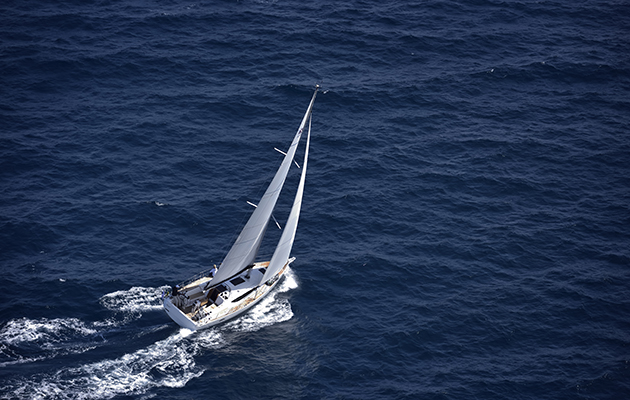
Offshore sailing skills: All you need to know
Will Bruton finds out what coastal cruisers should consider before taking their small yacht on an offshore adventure

Monohull or multihull: which is best for blue water?
As former editor of Yachting World, David Glenn has plenty of experience of both monohull and multihull cruising. Here he…

How to sail Biscay: 3 ways to tackle the milestone
Beyond Biscay is a diverse coastal cruising ground and the route to the warm waters of the Mediterranean. Will Bruton…
Their cruising costs were around €2,500 a month for the two of them, averaging out the most expensive parts of the journey from Sweden to the Canary Islands, when harbour fees were costing around €40 a night.
This would cover some eating out ashore and car rental for tours.
Over the longer term, a good rule of thumb is to allow 20% of the cost of your boat for running repairs to cover antifouling, sail replacement, servicing and, if you are leaving your boat to return home, you’ll need to factor in haul-out, storage and hurricane tie-downs.
If you plan to buy a boat, sail it back and sell it right after your trip, however, you may be able sidestep some ongoing costs.
Cutting the cord
Maybe you don’t have to wait until retirement to go cruising.
There is a strong argument for taking a career break (or breaks) and working for longer if necessary as it spreads the cost and reduces the risk of the big adventure never happening.

Additional offwind sails, like a furling Code 0, can keep the boat moving in light airs for more enjoyable sailing and to save fuel. Credit World Cruising Club
Around half of the people I meet on transatlantic rallies are taking sabbaticals and intending to return to the same post, or have quit a job.
Both options have become quite acceptable, and in some professions and countries sabbaticals are actively encouraged as a retention incentive.
‘Tell the world you are leaving,’ advises Kaj Maass.
‘Make sure you create some pressure on yourself to realise your dream. Involve your employer early on in the planning process. A modern employer will understand and respect your decision to explore the world and live out your dreams, maybe they even see a long-term benefit from the knowledge and experience you will gain from it and you can [negotiate] a leave of absence.’

Satellite comms add a level of safety and keeping in touch but can be costly. Credit: Richard Langdon/Ocean Images
Those running a business may bring in a trusted general manager or step up a family member while they are away.
Keeping tabs on business while away is possible (though it can be expensive in satellite data) but it’s not something that generally works well on a day-to-day basis.
You do need to be able to cut the ties to enjoy cruising, not least because the cruising life comes with its own workload, from maintenance to laundry.

Long-distance cruising comes with its own workload and maintenance. Credit: Kaj Maass/Malin Andersson
‘Trying to mix work and pleasure compromises both,’ says Stuart Letton.
Before setting out, the Lettons brought their son in to run their web-based business supplying global brands with customisable marketing material.
‘While our business was under new management, it was still a struggle for me to let go. I can remember sitting in WiFi cafés from Spain to the Galapagos trying to blend cruising with work and, while it helped my conscience, I doubt the effort did much for work or cruising.
‘That’s not to say it isn’t possible. With good WiFi and satellite connections you really can work pretty much anywhere . But if you don’t need to, I’d cut the ties, burn the bridges and go. If you need to work, fine, just get your management team in place, communication systems properly set up and resourced, and go.’

It helps to set a deadline so you can realise your dream and sail across the Atlantic. Credit: Kaj Maass/Malin Andersson
However you plan to break free, what really helps is a deadline: a date that you are going set off, with a scene you can visualise to keep you motivated as you work through the preparations and demands of shore life.
Most preparations are really just logistics, and you’re probably already pretty good at that.
The bigger obstacle is often mustering the courage to leave.
I often hear cruisers describe hassles – one described cruising as the act of sailing from one place where you couldn’t get something fixed to another where you hoped you would – yet when I ask for their best advice it usually boils down to a simple prescription: just go.
Kaj Maass said exactly that when I asked him that question.
‘Just do it. Life is too short not to live out your dreams.’
To rally or not?
This is entirely a personal choice.
Advantages of the ARC , which is the best organised and biggest, are great seminars, preparation information and tools.
It’s also an ideal way to meet lots of fascinating, like-minded people, and is agreed to be good value despite costs.
It also gives you a departure date to hold yourself too.

For a first taste of ocean sailing, it can be reassuring and fun to join a rally to sail across the Atlantic, like the ARC. Credit: James Mitchell/World Cruising Club
Plus is has good parties and entertainment on tap to keep crew happy.
The cons would be its early crossing date for the Tradewinds season, large fleet size (though check out ARC+, which is smaller) or if you just want to be low-key and go it alone.
The Viking Explorers rally is one alternative, but not many others still run.
If you do your own thing, you will still find a wonderful cruising community anywhere cruisers other, and there is fantastic support across the world for independent voyaging through the Ocean Cruising Club.
Preparations for sailing across the Atlantic – the basics
While in no way a comprehensive list of preparations, here are some jumping off points to think about when planning your voyage:
- Learn how to service and maintain your engine and key machinery, have a good set of tools on board. Video repair tips and techniques when you have technicians on board to refer to later.
- Have your yacht lifted, antifouled , stern gear serviced, and anodes replaced. Consider fitting a rope cutter . Also check steering systems and replace rudder bearings.
- Create a boat manual with all your procedures, equipment and the location of safety and medical equipment for crew to access.
- Fit an autopilot capable of handling your yacht in an ocean swell, fully laden downwind in 30 knots of breeze. Have a back-up if shorthanded, or two separate systems for redundancy.
- Have power systems checked and replace or upgrade batteries if necessary . If you upgrade batteries, consider if additional charging is necessary .
- Get first-class safety equipment for all crew on board.
- Have all sails serviced by a sail loft and consider double stitching all panels. With slab reefing mainsails, get a deep third reef.
- Set up a good boom preventer for downwind sailing on both tacks. That can be just lines and blocks but set up so you can gybe and switch preventers without leaving the cockpit.
- Check all running rigging and ensure you have adequate spare halyards set up before you depart. Think about chafe prevention.
- Choose your crew carefully. Make sure you are all comfortable sailing together and that roles are established well before you leave.
Enjoyed reading How to sail across the Atlantic and back?
A subscription to Yachting Monthly magazine costs around 40% less than the cover price .
Print and digital editions are available through Magazines Direct – where you can also find the latest deals .
YM is packed with information to help you get the most from your time on the water.
- Take your seamanship to the next level with tips, advice and skills from our experts
- Impartial in-depth reviews of the latest yachts and equipment
- Cruising guides to help you reach those dream destinations
Follow us on Facebook , Twitter and Instagram.
- Yachts for Sale
- Sales Report 2024
- FAQ – Luxury Crewed Yacht Charters
- FAQ – Bareboat charters
- FAQ – Sell your Boat
- FAQ – Buying a Yacht
- How Much does it Cost to Charter a Luxury Yacht?
- All Blog Posts and News
- Yachting for beginners
- Indian Ocean
- Mediterranean
- Sales & New build
- Motor Yacht
- Event & News

Best Yachts for Transatlantic Crossing: Our Selection and Advice for 2023
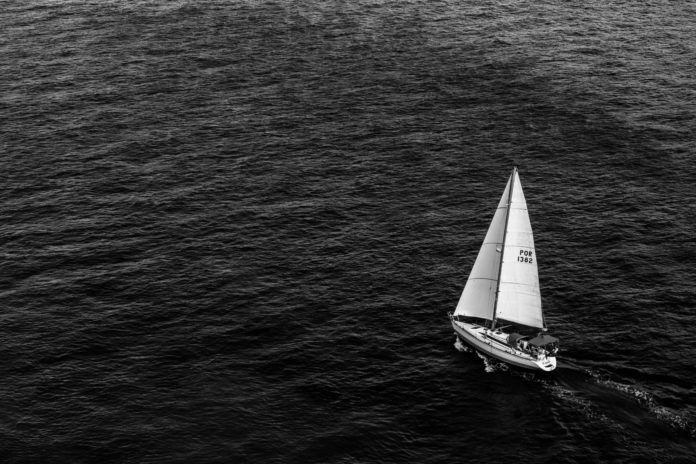
Sailing across the Atlantic is more than just an item on a bucket list for sailors. It’s how you get your boat to new horizons, whether to cruise the Caribbean islands or explore the waters around Europe. It’s a big undertaking and requires serious planning and a solid sailing vessel. You can cross the Atlantic by yourself, with a rally of like-minded racers and cruisers, or as part of a highly competitive race. But no matter how you go, the choice of a good sailing yacht lies at the foundation of a safe and enjoyable crossing.
What does a boat need for a transatlantic crossing?
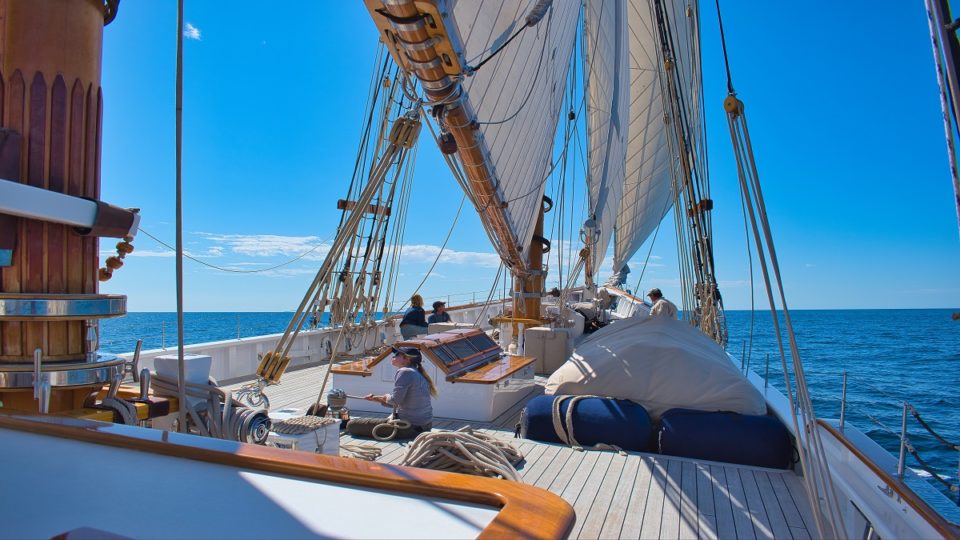
If you choose to do your transatlantic crossing with a rally or race, you’ll have to meet a stringent list of required equipment and safety checks. That’s easier because you have the lists right in front of you, and a team of inspectors to check your work. Preparing for a crossing with just one boat, the captain has to take all the responsibility and know what to check.
Sailing across the Atlantic is a serious undertaking, and you will sail out of range of shore-based rescue and into rapidly changing and possibly severe weather systems. You will have several thousand miles of nonstop sailing and may be at sea for several weeks.
What you must have
Any boat sailing across the Atlantic needs solid construction and a sound rig, a reliable auxiliary engine, and enough stores for food and water for the crew. That’s a bare minimum. Every boat needs to be checked from stem to stern to make sure systems are reliable, many older boats can certainly make this trip, and not every new boat is suitable.
Some tiny boats have crossed the Atlantic, so minimum size isn’t a requirement. What successful boats have in common is a solid hull and rig, with reliable sails and systems.
Most transatlantic yachts have a lot more
You can cross the oceans with a lightly equipped boat with few conveniences or extra safety gear, but most do not. A few things to look for on your boat include:
- An EPIRB satellite rescue beacon .
- Long range communication devices, such as satellite phones and single sideband radios.
- Certified life raft with space for all crew on board.
- Storm sails
- Storm safety gear such as drogues or sea anchors.
- Access to up-to-date weather forecasts and reports.
Do not head offshore without these
The list of required equipment for races and rallies is exhaustive, and many of the requirements are exacting and expensive. No one is enforcing compliance when you sail on your own. But there are a few things you should not head offshore without.
- A reliable auxiliary engine. If the wind dies and you need to dodge bad weather, this can be a lifesaver.
- Access to good, current weather information.
- Reliable sails. Have all sails inspected by a sailmaker for wear and damage before setting out.
- A life raft. If you run into serious problems and lose your boat, this is your last hope for rescue.
- Spare parts and tools for common repairs.
Read also: 10 Sailing Myths And Bad Advice You Shouldn’t Listen To
What experience do you need to do a transatlantic?
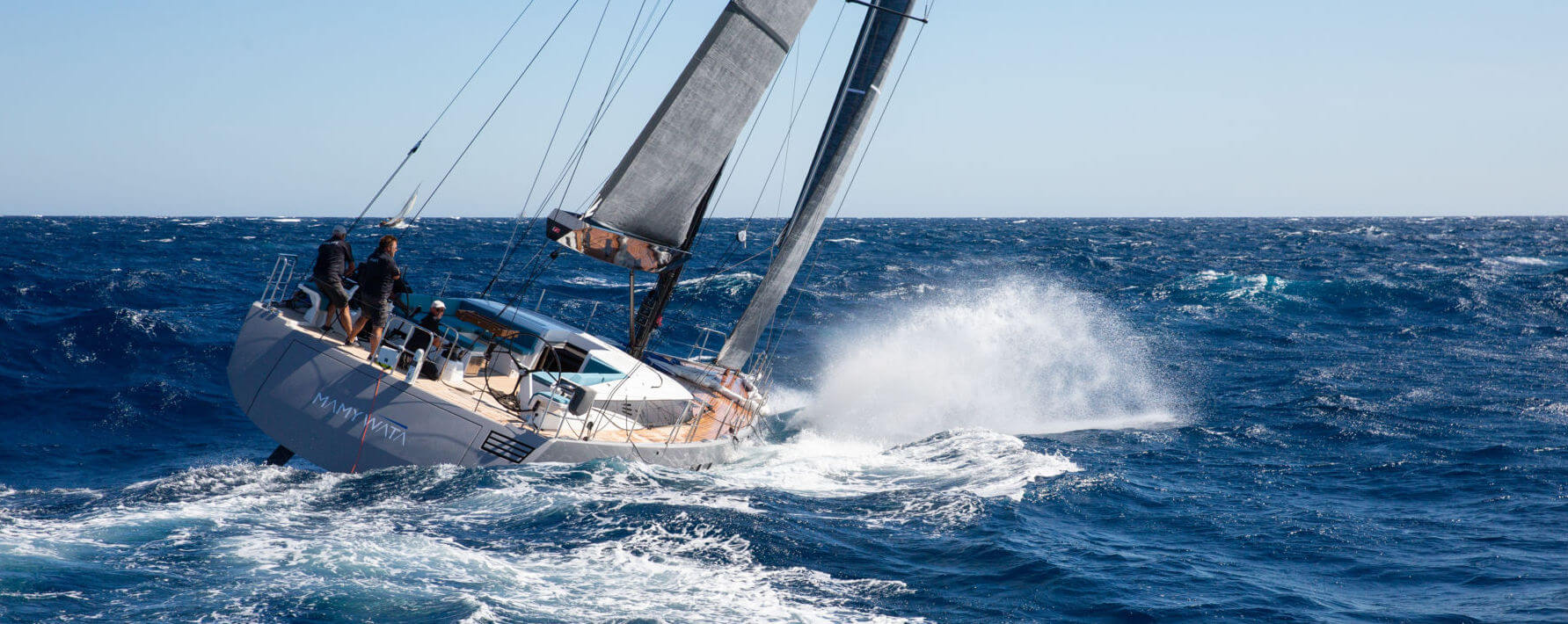
A transatlantic crossing is a major sailing milestone for experienced sailors. The north Atlantic is no place for new sailors and beginners, unless they’re with competent and experienced crew or a qualified captain.
If you’re thinking of a transatlantic crossing on your own, you’ll need experience with multi-day, nonstop passages. Sailing offshore is twenty-four hours a day and nonstop, there’s no place to park. Experience with night sailing, standing watches, navigation, provisioning, and basic engine and system troubleshooting are all a must.
Read also: Five Easy Beginners-Friendly Sailing Trips And Destinations
Chartering a yacht – a great option for less experienced sailors.
Charter fleets make seasonal moves from Europe to the Caribbean are an excellent way to get offshore sailing experience. Charter companies provide a captain and first mate, but you can reserve a spot and fill the roles of a full crew member, standing watch and sailing far offshore.
Many boats are also available for charter in cruising rallies, races, and deliveries. You’ll need to hire a captain with the needed offshore experience, but you may come away with enough experience to skipper your own yacht the next time.
The best yachts for a transatlantic crossing
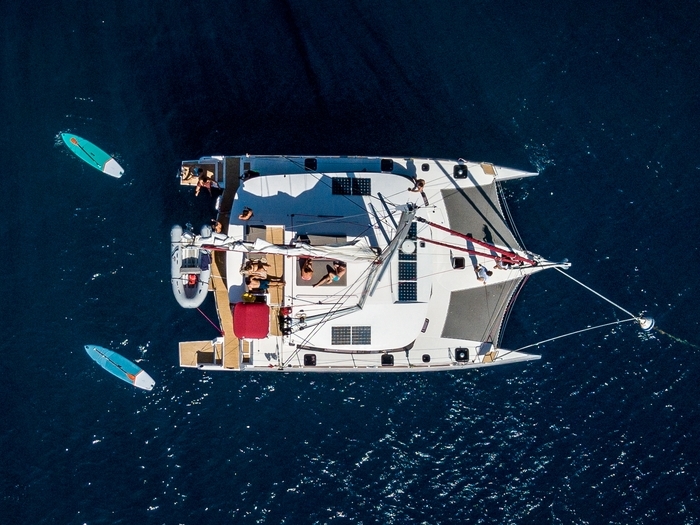
There are many yachts which are suitable for a transatlantic passage. Some will be less expensive, some will be more comfortable, faster, or better suited to you, your experience, and your budget.
NEEL 51: Fast and easy to sail trimaran
The NEEL 51 is a fast, comfortable trimaran suited to a smaller crew. It’s spacious, but easy to handle while putting up double digit speeds and 200+ mile days. Trimarans can be a little more sea-kindly in waves and chop than catamarans, and don’t heel hard like monohulls. A protected helm station gives great protection offshore and good visibility, and there space on board for plenty of crew and guests.
The racing version of the NEEL 51 is built with lighter materials, and features a larger rig to project more sail area for more speed, while still affording the same luxury and comfort at anchor.
More info about our Neel 51 available for charter
Outremer 5X: High-speed catamaran sailing
The Outremer 5X offers top tier performance and comfort in a single passage. Sustaining double digit speeds with east, the Outremer 5X is one of the fastest cruising catamarans on the market. Outremer is known for both performance and quality, and your transatlantic trip will be fast and safe.
With four different helm stations, she’s a sailing boat foremost. It’s designed for a small crew, even when tearing up the ocean on a fast passage. With options for three or four cabins and a cockpit that can fit a dozen people, she’ll be as comfortable when you arrive as she is fast on passage.
Hallberg-Rassy 57: Sturdy monohull with elegance and speed
Hallberg-Rassy builds tough cruising yachts, and the 57 is no exception. While monohulls don’t put up the blistering speeds you’ll find in multihulls, the Hallberg-Rassy 57 is no slouch and can log 200 mile days. Most offshore sailing and cruising is done in monohulls, and blue water sailors love their stability and seakindliness across all conditions.
The Hallberg-Rassy 57 has generous accommodations, and loads of capacity for gear supplies. The deck layout is clear, and lines and controls are laid out for easy use with a small crew. With a performance design by German Frers, the 57 sails well on all points of sail.
There are many choices for the best boat for you for a transatlantic crossing. No matter which boat you choose for your transatlantic and how you go – on your own, or on a charter – preparation is key. Your boat needs to be equipped with a full range of safety gear, and checked from top to bottom so you know your sails, hull, and engines will get you where you’re going.
Read also: The Caribbean To Mediterranean Sailing Routes: How To Cross The Atlantic Eastward

RELATED ARTICLES MORE FROM AUTHOR
6 great motoryachts just under 100 feet to consider, how to winterize your boat, sail the mediterranean onboard the custom line navetta 28 “yvonne”.
- Testimonials
- Privacy Policy

Crossing the Atlantic on a Lagoon 42 Catamaran
In November of 2022, I joined the crew of the Lagoon 42 catamaran Games Maker II during the westbound Atlantic crossing from Gran Canaria to St Lucia. The boat was part of the 2022 Atlantic Rally for Cruisers (ARC) .
The crew included the British boat owners couple Tony and Lel and their old friend Joz from Australia. Tony is an RYA Yachtmaster offshore with significant experience, including a previous Atlantic crossing. He grew up as a monohull sailor and previously owned an Amel. Lel and Joz were also experienced, both at the RYA day skipper level. So we had all the ingredients for a safe and hopefully fast passage.

My role was to serve primarily as the navigator and to provide advice on sailing tactics. I’m an avid racer so Tony was hoping I could bring some racing tactics to the mix to make us competitive. Although we were not in the racing division (the L42 is not a racing boat), we wanted to sail as fast as possible with the goal of keeping up with the much larger catamarans in our division. Specifically, we were part of the Multihull B division that included production non-performance cats under 50 ft. Most cats in the division were in the 45-46 foot range. We were the third smallest cat in the fleet, only larger than a single Lagoon 380 and a couple of Nautitech Open 40s. The Multihull B fleet was dominated by Lagoon 450s and 46s.
In the end, we did fairly well. Despite the unusual passage described below, we finished 2 nd in Multihull B and 8 th in all multi-hulls.

An Unusual Passage
The westbound Atlantic crossing between the Canary Islands and the Caribbean is one of the most reliable trade wind ocean passages in the world. The trade winds blow at 15-20 knots from the east consistently and boats expect to sail fast towards the Caribbean with strong down winds and following seas.
Yet, Neptune had different plans for 2022. The first two weeks were as expected, with strong winds and fast sailing. However, a low-pressure system soon began to form in the mid-Atlantic. By day 12 the system evolved into Tropical Storm #22. Although the storm was far enough to our north to pose no threat, the counter-clockwise rotation of the TS winds clashed against the easterly trade winds reducing them to nothing.
Consequently, TS #22 turned the last week of this passage into a headwind bash. The low-pressure system stalled in the worst possible location creating westerly winds coming directly from our destination. For a full week, we experienced headwinds from 0 to 15 knots forcing us to motor sail close haul when the wind was strong, or to motor with no sails directly to the destination when the winds were light.

In numbers:
- Total Miles GPS: 2901
- Total Miles Over Ground: 3079
- Days at sea: 20
- Hours at sea: 490
- Average miles per day: 153
- Max miles per day: 185
- Average Speed Over Ground: 6.35 (7 knots during weeks 1-2 and 5 during week 3)
- Average VMG-Course: 5.45
We completed the passage in 20.4 days but quite unevenly, thanks to TS#22. We sailed 2000 miles during the first 12 days (~166 miles/day) but it took us eight more days to sail another 1000 miles (~125 miles/day).
Performance and Comfort
The L42 can be pushed to sail very fast, even in rough seas. During the first three days with very strong winds, we sailed at 8-9knots consistently and saw single digits often. On our fastest day, we covered 185 miles. That may not sound impressive compared to a 200m+/day 50ft performance boat. But this is not a performance boat. It’s a 42ft production cat!
The metrics for the first two weeks when we had wind were outstanding for a 42ft boat. We averaged 7knots. We experienced four days of over 170 miles and nine days of more than 160. In contrast, the performance suffered during the last week because of TS#22. We had extremely low winds most days, and the little wind we had was 100% on our nose. Combined with a need and desire to get to St Lucia (mostly my fault as I was the one with flights to catch), we had to motor sail quite a bit! So, our average during the 3rd week dropped to 5.1 knots, with most days sailing between 110 and 130 miles.

Sailing fast. While this boat can sail fast, as we experienced during the first two weeks, it is not a comfortable fast boat . It just lacks the rigidity and type of construction necessary for a gentle and quiet motion. And it is just too small to glide over fast cycling waves and chop. All of these factors combine to create a rough and loud ride when sailing in speeds above 8 knots in ocean seas, especially inside the hulls. This ride will quickly wear down any non-racing crew.
Sailing over 8 knots in rough seas feels like driving a Toyota Camry at 100 miles per hour in the Paris-Dakar rally.
But this should not be viewed as a criticism of the L42 (or the Toyota Camry). It is simply a design characteristic that owners and potential owners should accept, especially those, like me, who are performance oriented. It Is all about priorities. We could sell Blue Buddha and buy a performance catamaran, or we can keep the L42 and cruise for 10 more years with the price difference.
Sailing slow. Now, while this boat is not a comfortable fast boat, it is comfortable at moderate speeds. Downwind sailing at 7 knots, even with 3m seas felt as comfortable as any larger cat and can be maintained for days without wearing down the crew. When upwind, I found the sweet spot to be just at or below 6 knots. During one of my night shifts, while beating into 15 knots of wind close-hauled, we took down the code zero and brought out the jib. The boat speed dropped from 7.5 to 5.5 and the boat motion improved dramatically. That night was one of the most peaceful watches of the trip, even though we were going upwind. And I am pretty sure the crew got a good night sleep that night. So yes, the L42 can be a comfortable passage-making boat but not at high speeds unless it is modified significantly.
Noise . Without modifications, the L42 is unfortunately a very creaky and loud boat, especially in heavy seas. During the first couple of weeks, we experienced two simultaneous swells in slightly different directions that resulted in significant wave slamming under the hull. The lack of rigidity resulted in a very strong vibration pattern transmitted throughout the hull every time the waves slammed. It made me wonder if increasing the rigidity would improve the experience inside the hull during passage. In addition, as often reported, the furniture of the L42 is quite creaky and this noise is maximized as the boat twists in heavy seas. Some owners have successfully minimized the noise by identifying loose seams and putting shims. We will definitely dig deep into the furniture to address the creaking on Blue Buddha, but it is unfortunate that Lagoon did not address that from the start.
The helm. Without a doubt, the helm was the most comfortable and quiet place on the boat. A couple of times, in heavy seas with significant slamming, I woke up in my cabin thinking that something was wrong. I would then go upstairs to check with the person at the helm, only to realize the helm was quiet and comfortable. The person at the helm was smiling and oblivious to the chaos happening below. Over time, most of the crew began sleeping in the saloon whenever possible, as it was significantly quieter and more comfortable than sleeping in the hulls.
This made me realize that our plans to make modifications to the saloon must preserve the ability to turn the saloon into a bed as it is the ideal sleeping location during passages.
We used two primary sources for navigation and routing. First, Tony hired a UK-based weather router who was in daily communication with us. In addition, we used Predict Wind Pro and I employed a fairly standard passage-making approach. Specifically, I downloaded the grib files and routing information for all weather models twice per day. I compared the suggested routes against real conditions (wind and boat performance) and against the UK weather router’s recommendations and made suggestions about our course accordingly.
Given our results, I would say this approach worked pretty well. The only exception was during the third week when the winds had turned to westerlies and we could not make progress directly to St Lucia without beating into waves. Predict Wind suggested we head north for 24 hours and then south as the wind was expected to veer north so we could sail south towards St Lucia with the wind on our back.
The problem was that the wind took a day longer than expected to veer so we got stuck north and had to close haul south. We essentially sailed 150 unnecessary miles and wasted more than a day doing what would be known in the fleet as the “North Pole Detour” or the “Polar Circuit”. As you can see below, we were not the only ones that got stuck on this polar detour. Those boats that ignored that recommendation and continued directly to St Lucia were rewarded.

And for the record, I give credit to Tony who suggested we should avoid the northern route and motor directly to St Lucia. He unfortunately listened to me instead of following his instincts!
The importance of good polars. A critical limitation of our navigation approach is that we did not have really accurate polars for this specific boat. The quality of the Predict Wind routes depends significantly on the accuracy of the boat polars. Predict Wind has some default polars for the L42 but those polars are extremely aggressive and non-realistic for a passage-making boat. Those were likely created on an empty boat with a racing sail plan. I did not use those polars and instead used Blue Buddha’s modified polars. Although my polars were more accurate than the Predict Wind L42 defaults, my polars were based on a different sail plan than the one we had and thus, the polars often overestimated our speeds and angles. I could not emphasize enough how important is to create your own polars based on your own sail plan and sailing style so that the Predict Wind routing models are as accurate as possible.
Here are the polars we used, which worked most of the time.

Games Maker II had a fairly standard set of head sails that included a very flat code zero and a cruising asymmetric spinnaker. This spinnaker was relatively small (120sqm) and strong (2.4oz), which allowed us to fly it in up to 20knots of AWS. However, we were hesitant to fly the spinnaker at night, given our small crew and relatively short time sailing as a team. So we were limited to flying white sails at night or using the furling code zero, which worked relatively well, but it was not as fast as the spinnaker.
Changing our sail plan. My experience with this sail plan during the passage made me reconsider the sail plan we discussed with UK Sailmakers. Specifically, I realized that relying primarily on sock-based spinnakers for downwind sailing when short-handed is not ideal, as it means having to fly only white sails at night or when many squalls are expected. This is especially true in the case of Blue Buddha since we will be sailing the boat two-handed in most overnight passages. I also realized that in moderate winds (15-20), I would not like to be flying a sock-based spinnaker when it is just the two of us as it is unnecessarily risky.
So when I returned home I sent an email to our sailmaker to make a major change to our sail plan order. We will still plan to have a large A2 in a sock for very light winds. However, we eliminated the A3 and S4. Instead, we will get a furling cruising gennaker that can sail in 90-170AWA. This will be a game changer during passages as it will allow us to fly the gennaker at night, even when it is just the two of us. If the wind increases or a squall approaches, we could simply furl it and deploy the jib. And once the squall is gone, we can redeploy the gennaker in seconds. I will be writing an update to our sail plan article soon.

A code zero issue. When we were on a beam or upwind we used a relatively large code zero (80sqm). The performance of this code zero was amazing but with a major caveat. The L42 can point well in strong winds with the jib. It can also point well in very light winds with the code zero. But there is a problem in moderate winds (12-17 knots). In such winds, the jib does not provide enough power so you need a different sail. However, the code zero’s power becomes an impediment to pointing. The problem is that this code zero max safe speed was 18knots AWS and it would start collapsing at 50AWA. When the wind was 13+ knots, the code zero resulted in a rapid acceleration and got the boat to sail at 7-8knots. This may sound ideal, except that this acceleration created two major problems: 1) it made the boat reach the 18+ of AWS quickly and 2) it moved the apparent wind forward significantly so were pushing 50AWA when the TWA was barely below 90! The response to the high AWS was to bear away, which slows the boat, but the TWA did not improve much below 90, so you are essentially not going upwind at all. The only solution I can think of for this issue is to have a code zero that you can reef in 13 knots and fly it inside the stanchions/shrouds so that you can point higher (~45AWA) while keeping the boat speed below 8. Otherwise, you would have to fly the jib when going upwind in 15 knots. It will be slow but at least you will be going upwind.
Issues and Broken Systems.
All boats, regardless of how “blue water capable” they are, will have things break during an ocean passage. Several boats broke major components. One broke its boom and another was fully de-masted with over 1000 miles to go. Many boats destroyed their spinnakers and chaffed through major lines.
We were very lucky in that we broke almost nothing. The full list of issues is short and relatively minor:
- During the first week, the starter motor of the generator stopped working and Tony simply hotwired the starter and we were able to use the generator as needed without issues.
- We blew the main halyard block at the base of the mast after I forgot to release the mainsheet when raising the mainsail. Yes, I make stupid mistakes sometimes!
- The first and second reef lines began chaffing significantly but were still operating after 3000 miles.
- One of the mainsail batten carts kept coming loose and we had to secure it with a Dyneema line. This is a common problem. The original batten attachment is plastic and the female thread wears down so much that the bolt that connects the cart to the batten comes loose. We’ll make sure our next main sail comes with battens with metal threads.
That is all we broke. Pretty impressive for an Atlantic crossing.
In sum, this was an excellent, safe, and relatively fast passage with a great crew. I learned a lot about how the 42 behaves in a variety of conditions and about its suitability for our circumnavigation.
So is the Blue Buddha still the boat for our circumnavigation? Yes, but not without major changes to increase comfort, rigidity, and a new sail plan. In fact, here is a picture of a Toyota Camry ready for the Paris Dakar rally. It can be done :-).

Share this:
- Click to share on Twitter (Opens in new window)
- Click to share on Facebook (Opens in new window)
Related posts

From Charter Boat to World Cruising: The Refit of Blue Buddha – Part I

Tacking the Lagoon 42 Catamaran

Eco-Friendly Toiletries
Leave a reply cancel reply.
Hi Nestor, I’m just curious as a lagoon owner,what happened to the other lagoon 46 s Thanks Caner
Nothing. The first two days were very rough so a few boats came back to wait for better weather. Then they decided to spend another season in the med.
Great insight…I have a 20 Lagoon 40 and have utilized some of your recommendations on my passage from TX to Key West…we encountered a low with sustained 37-38 TWS and gusts into the 40’s and while extremely uncomfortable she handled well and aside from a few well timed prayers I never felt we were in serious trouble…the Gulf is like a confused washing machine in storms like we encountered and the noises from flexing and twisting had me thinking at times the hulls were separating, I had a very experienced Capt onboard and his calmness was huge..I can attest to the chaffing of our reef lines, our reef one actually snapped..from research it seems to much friction with Lagoons current reef line set up is the culprit…and many have added blocks to alleviate it. Anyhow thank you for your insight on an incredible journey that was probably an incredible experience from a learning, achievement and enjoyment standpoint!
Terrific post, Nestor. Thank you.

Is It Safe To Cross the Atlantic on a Catamaran?
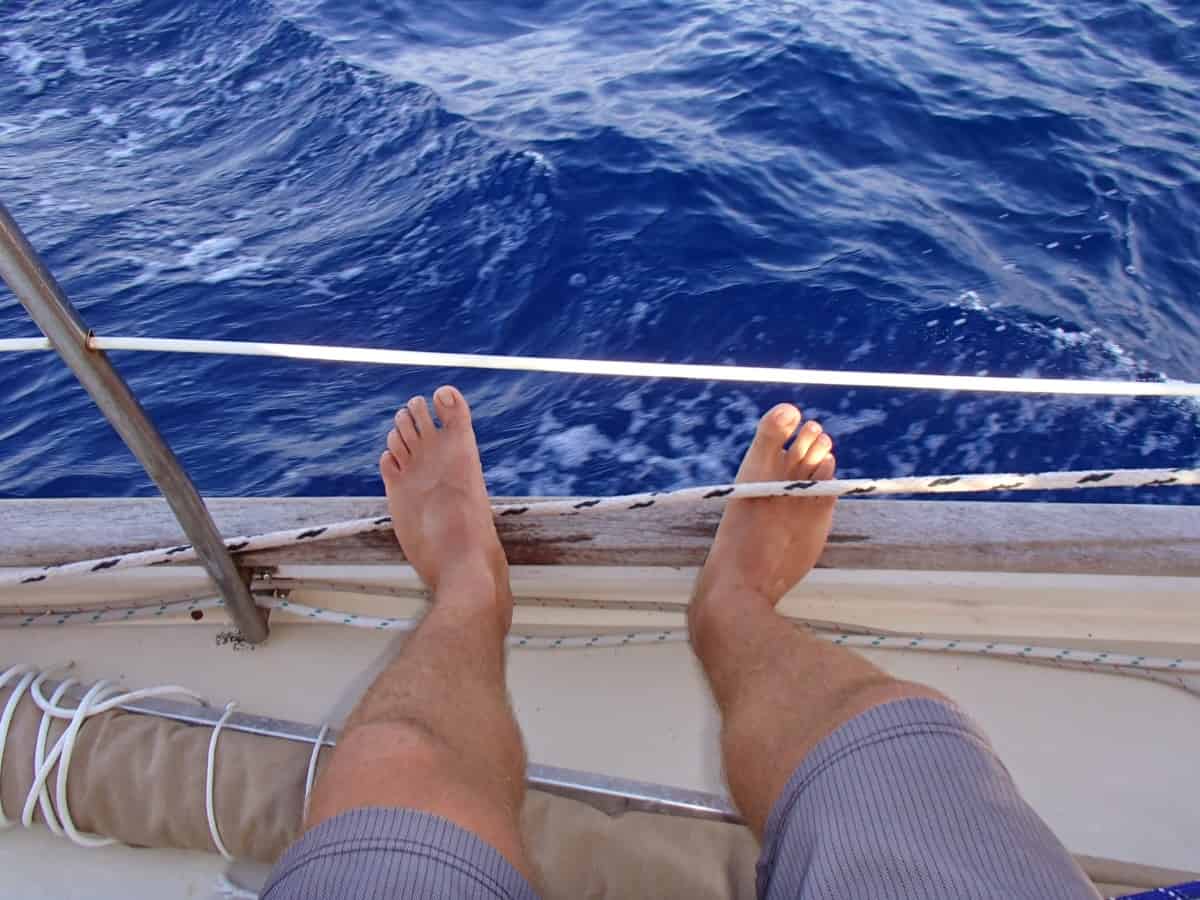
As an Amazon Associate, we earn from qualifying purchases. We may also earn commissions if you purchase products from other retailers after clicking on a link from our site.
Many sailors consider sailing across the Atlantic as the ultimate proof of their skills. But bluewater sailing requires a safe vessel that can withstand the harsh conditions of the open sea. Many are these discussions about whether or not catamarans are suitable for crossing the Atlantic.
It is safe to cross the Atlantic in a catamaran thanks to the sailboat’s design. Catamarans do not have ballasts in their keels. Instead, they have two hulls and rely on a wide beam for stability. The design increases buoyancy, speed, and motion comfort, making the boat safe for long-distance travel.
Keep reading to understand why a catamaran is a safe vessel for crossing the Atlantic Ocean. This article will also show you the type of catamaran you should travel in if you plan to sail long distances .
Are Catamarans Good for Long-Distance Travel?
One of the first things you need to consider when planning a long-distance trip on the water is whether your vessel can handle that type of journey. And cats come in different sizes, ranging from small to large boats.
As you probably already know, not all boats can travel long distances, particularly across the ocean.
You need a sailboat with a large fuel tank capacity, enough room to house the crew and passengers, and the ability to sail in heavy seas.
Catamarans are good for long-distance travel, as they are often more comfortable and stable than monohull sailboats. An Atlantic-crossing suitable catamaran measures around 40 to 50 feet (12 to 15 meters) long, which is size is ideal for long-distance travel with a small crew.
Choosing the right size for an ocean-crossing cat is important. A large-enough sailboat provides adequate room in the living spaces and can accommodate cooking spaces, separate dining areas, private bedrooms, and more than one bathroom.
Another reason cats are good for long-distance travel is their speed.
Most catamarans can travel up to about 150 nm per day.
Some catamarans can even travel a little over 200 nm a day.
In any case, the speed and distance a cruising cat can cover per day all comes down to wind strength and sailing performance.
Can Catamarans Handle Rough Seas?
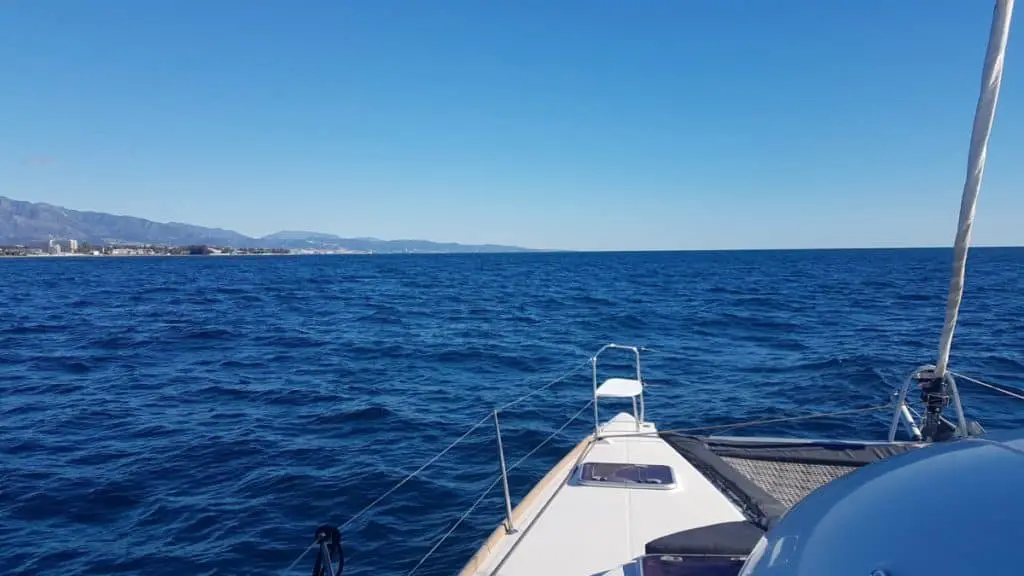
Catamarans were originally logs bound together for fishing in India. Their original name is kattumaram .
Of course, modern cats come in sophisticated designs suitable for fast sailing and leisure cruise in open waters.
But can cats handle big waves and stormy weather conditions on the sea?
Catamarans can handle rough seas and maintain good stability in stormy weather. The vessels have a lot of buoyancy and high resistance to capsize, furthermore, the high speed allows them to faster reach their destination.
However, not all cats are created equal.
Knowing the various types of cats and their best use cases is essential if you plan to cross the Atlantic Ocean in a catamaran.
Here’s a small list of the common catamaran types:
- Racing catamarans
- Beach catamarans
- Cruising catamarans
The most suitable catamaran category for sailing across the Atlantic Ocean or even around the world is the cruising catamaran.
These sailboats can handle rough seas because they have extra safety features not found in other categories, such as recreational racing cats.
Safety Features of Cruising Catamarans
Cruising cats have extremely strong cockpit windows that can withstand boisterous ocean waves crashing into them. These windows are strong enough to resist storms during heavy weather sailing.
Other design elements that ensure the safety of cruising cats are:
- Redundant systems: Cats have several redundant systems or duplicated critical components that increase their reliability in the open sea. These include two motors, two hulls, and two rudders. Even if one hull gets destroyed the other hull will be able to keep the boat afloat.
- Watertight emergency hatches: Cruising catamarans have closely sealed hatches that serve a dual purpose. First, they provide access to different compartments in the sailboat like the living space, cargo, and storage. Secondly, watertight hatches keep water out of these compartments, making them safer in stormy weather. There are also hatches made too evacuate the crew if the caravan gets flipped upside down.
- Positive buoyancy: The construction materials for catamarans and the absence of ballast make them very stable on the water.
Remember that all sailboats experience some degree of rolling when moving through rough waters.
Cats are no different, but the good news is that cruising catamarans are stable and very unlikely to capsize due to their wide base and high stability.
Still, trimarans have even greater stability than catamarans! Read more here.
Overall, the safety features and design elements mean that voyaging across the Atlantic in cruising catamarans is generally safe.
How Long Does It Take To Cross the Atlantic in a Catamaran?
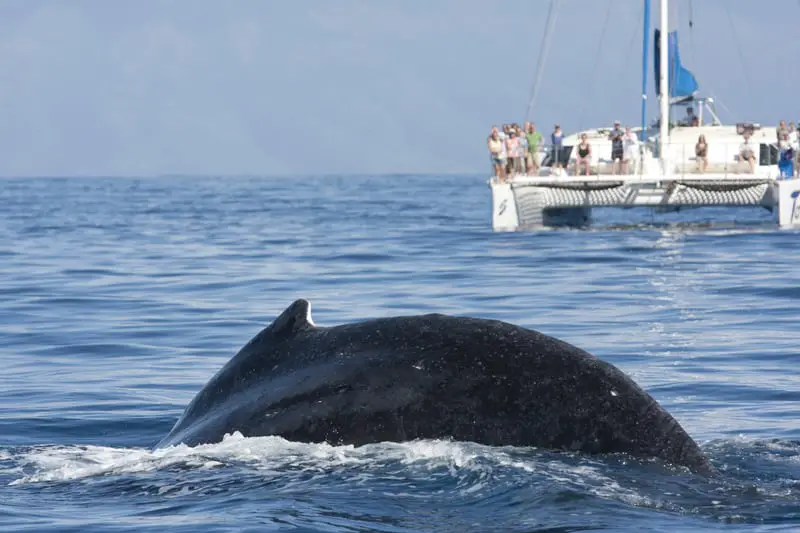
It takes two to four weeks to cross the Atlantic in a catamaran. However, the duration depends on several factors, including the route, vessel speed, and weather conditions.
You can complete your voyage in about three weeks if you maintain an average speed of 9 to 10 knots (10.5 to 11.5 mph, 16.89 to 18.5 kph).
On the other hand, it is more common to spend a little over a month crossing the Atlantic Ocean since maintaining an average speed above 6 kts on a cruiser cat is very hard.
For example, your trip may extend for a few extra days if there is no wind or low wind strength for some days. Especially in the doldrums.
So, if you plan to cross the Atlantic, it is best to bring supplies that will last everyone on board for up to a month, especially if you are not sure about the weather.
After all, sailboat safety isn’t only about the vessel. You also want to consider the well-being of the crew and passengers onboard the boat.
Owner of CatamaranFreedom.com. A minimalist that has lived in a caravan in Sweden, 35ft Monohull in the Bahamas, and right now in his self-built Van. He just started the next adventure, to circumnavigate the world on a Catamaran!
Leave a Reply Cancel reply
Your email address will not be published. Required fields are marked *
Save my name and email in this browser for the next time I comment.
Recent Posts
Must-Have Boat Gear for Catamaran Sailors!
Sailing is probably the most gear-intensive activity I've ever done; there are so many decisions to be made about what gear to buy now, for tomorrow, and what to definitely never buy. The gear on...
6 Best Trailerable Trimarans For Bluewater and Coastal Sailing
Having a boat costs a lot of money, even when you are not using it, marina fees, etc. And once it is in the water most sailors never go very far from their "home marina" and sailing will be somewhat...
- The magazine
Current issue
- All the issues
- My magazines
- Technical specifications
- Multihull of the Year
- Classified Ads
- Destinations
- Online store
- All the magazines
- Subscriptions
- Accessories

TO CROSS THE ATLANTIC, OR NOT: THE IDEAL PROGRAMME
Create a notification for Catamaran
We will keep you posted on new articles on this subject.

Published 27/11/2008
By Jean-Christophe Guillaumin
Issue: Previous issues
Published: jan. / feb. 2013

Choose the option that suits you best!

Issue #: Previous issues
Published: January / February 2013
- Access to Multihulls World digital archives Digital archives
The classic
Other solutions, so, this atlantic crossing, are you going to do it, or not, most-read articles in the same category.
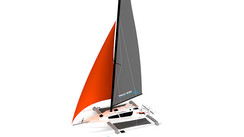
Tricat 8.50

Lagoon Neo program

Les Occasions du Multicoque et du Refit

Dragonfly Days 2024

Bourgogne Catamaran

Rapido Trimarans
What readers think.
Post a comment
No comments to show.
MW #197 - Oct / Nov 2024
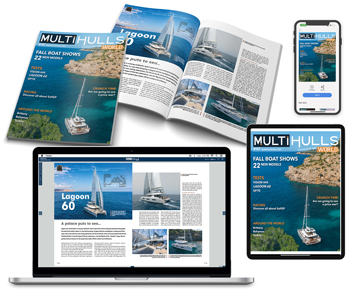
MiniCat 520
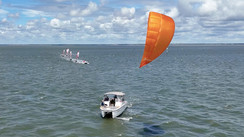
LibertyKite & Pinball Boat
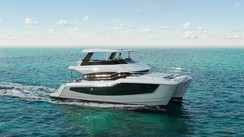
Aquila 50 Yacht
Subscribe now.
The latest news from €3 / month
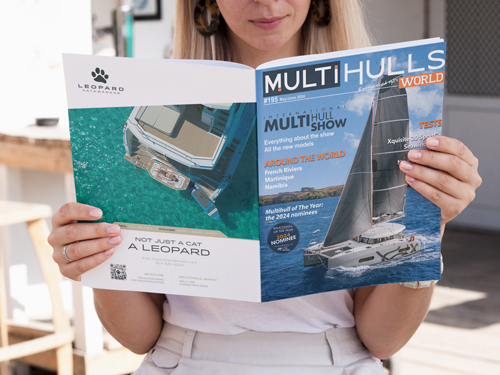
Video of the month
Our latest YouTube hit!

The Multihull of the Year
The 2024 results

Classified ads
TRICAT 30 PERFORMANCE

TRIMARAN FARRIER F9AX

Privilege 515 (2010 - refit 2021) v. 3 cabins

Power catamaran Fountaine Pajot Greenland 34 - fully self-sufficient
Vous avez ajouté " " à vos favoris., vous avez supprimé " " de vos favoris., in order to add this article to your favorites, please sign in..

What kind of boats cross the Atlantic Ocean? 7 Options explained
You're looking for a way to go across the Atlantic without flying. What options are out there? Here are 7 options explained. I sailed five of them across the Atlantic.

Sailing an ocean on a Small sailing vessel
Many privately owned sailing vessels cross the Atlantic to spend a sunny sailing season either in the Mediterranean or Caribbean or as part of their around-the-world voyage. It is a big deal for them and attracts all sorts of seamen and women: young ‘pirate’ dudes who have escaped the rat race, adventure couples, retirees, families, groups of friends, and single older sailors.
The largest share of the captains is between 50 – 65 years old. It's the group that has the time and money resources to sail. All sorts of nationalities make the crossing, with the French and Swedish seeming to dominate the fleet.
By crewing on a small sailing yacht, you'll be involved with every aspect of seamanship and sailing. You will learn a lot for sure. Many boats choose to stop in Cape Verde or the Azores, and often don’t have tight schedules.

Boats come in all sorts of shapes and materials. Hulls are made from steel, wood, aluminium, and today mostly of fibreglass. 90% of the boats crossing the ocean is bigger than 36ft, with most of them measuring around 44ft. (14m).
A smaller yacht could also be perfectly ocean-worthy. I've seen boats of 26 ft. crossing the pond. Some adventure people row across the Atlantic. In 2017 someone even Stand Up Paddled (SUP) across the Atlantic. Being on any boat is a luxury compared to that.
Six people (out of 100) I interviewed in my book crossed the Atlantic on a boat smaller than 36ft. and all of them would like to do it again. This year we also have Nadiem, Ocean Nomads member who'll sail across in his little sailboat.
Both monohulls and catamarans cross the Atlantic. Catamarans are generally faster, more spacious, and rock less. On the flip side: they can flip! If they do, it’s a major challenge to come up again. Don’t worry, this is extremely unlikely. Having seen hundreds of boats planning, preparing and making the crossing, I estimate that roughly 70% of the boats that cross are monohulls.
With Ocean Nomads we sometimes have small liveaboard sailing vessels looking for crew in the network to sail across, or members recommend a vessel from their networks.
In our brand new Ocean Nomads Crew Course , I share all the tips and tricks for finding and securing a safe sailing vessel with which to sail as crew. Eco & Adventure style. Proper preperation makes all the difference for a happy, safe and meaningful voyage.
Sail with me & Ocean Nomads in Greece in 2024! Level up your sailing skills and make ocean people connections accelerating your sailing journey. 4 vessels, 11 days, 30 nomads! Learn More.
Sail across the Atlantic on Superyacht
Many larger yachts cross the Atlantic as a ‘delivery’, where a boat needs to be taken from point A to B. Boats have to be moved across the ocean for a new charter season, for the private owner who will hop on board again on the other side, or because someone bought it on the other continent.
Usually, paid and professional crew do these types of deliveries. As an amateur crew member, you can be a cheap extra set of hands.
A yacht is a ‘superyacht’ when it is over 24 metres (79ft.). These are big yachts. They often have generators running every day to keep fridges and freezers going. They load up thousands of litres of fuel and water, and are less dependent on the wind.
As such, there is less risk and generally more comfort. These trips often run on a tight schedule, so there won't be much flexibility for stops along the way (like in Cape Verde or the Azores). In most cases, there will also be more people on board (five-eight people compared to three-five on smaller vessels).
Crossing on a big boat like this is faster, less adventurous, and more comfortable. The crew are often younger, and some live and work permanently on the boat. Many of them have crossed the Atlantic Ocean numerous times and are therefore less excited about it than the average ‘yachtie'.
Timelines are tight and there’s often not time for island exploration. Usually, you are expected to work hard. Also, it's not unusual that superyachts don't even use the sails to prevent damaging, and have the sails tip /top for when the owner comes on board.
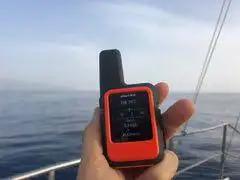
Garmin Inreach Mini2
A transatlantic on a charter yacht.
If you would rather not have the pre-crossing adventure or spend too much time searching for a boat, and/or if money is not an issue, you can book a charter ocean passage. Charter trips are organised on all sorts of boats: small, big, monohulls, catamaran, and racing boats.
Numerous racing yachts cross the ocean reaching boat speeds up to 35 knots! In addition to professional crew, spots are sold and you can sign up for a wet and speedy adventure guaranteed.
A charter trip costs between €2,000 and €10,000. An organized trip like this could be advantageous if you’re on a tight schedule. It’s more likely to leave on the planned date.
At the same time, the time schedule could be a disadvantage. What if the weather window is not ideal to leave? In many cases, though not always, everything is taken care of such as provisioning and cooking, so you wouldn’t have to figure out much yourself.
Charter organisations need to comply with a lot of safety requirements and check ups to legally carry out the voyage. This assures some safety but still you need to do your homework if it's a safe ride.
Another consideration of booking this type of passage is that you won’t know your shipmates. When you search the adventurous way, you have the opportunity to meet the other sailors before you commit to joining the crew. On a chartered passage you’re stuck with whoever else has booked the trip, even if you don’t like them.
With Ocean Nomads we work together with SV Twister and have the following Atlantic Crossings planned .
Sailing the Atlantic on a Tall ship
Every year, numerous tall ships sail across the Atlantic, like the Stad Amsterdam or Oosterschelde, and this year also SV Twister :) . Sailing across on a large traditional boat is spectacular. Many young people work on the tall ships. You could either try that or buy yourself a passage.
I wrote the above in my book, a friend of SV Twister reached out to me. Long story short, last year 2022/2023 I, with Ocean Nomads, organizing a trip across the Atlantic, Caribbean sea, and back across the Atlantic , and I now experience this way of sailing across also. You can join this trip in 2025 .

Update! We're back from the Atlantic. And we made a film about it:) Here is a the film about Sailing the Atlantic with Ocean Nomads. My 5th Atlantic crossing.
Travel the Ocean with a Sail Boat Ferry
There are no sailing ferries (yet), although boats are being built for this purpose. At the time of writing, Voyagevert is conducting feasibility studies to construct the fastest and largest sailing catamaran for a ferry service as a sustainable alternative to flight for transatlantic travel. Also Fair ferry is looking into it.
A transatlantic on a cruise ships
Another kind of ferry are the cruise ships. More and more cruise ships cross the Atlantic to do the season on the other side. They need relocation and spots on board are sold as ‘repositioning cruises.' It's often cheaper than airfare and your house rent combined. One option that is cool, is ‘ Nomadcruise ,’ an Atlantic crossing for entrepreneurs and digital nomads.
These floating cities are not an environmentally friendly way to cross. It takes around eight days and a lot of noise to cross with a cruise ship. Data on emissions is remarkably difficult to find. Some sources state that an average cruise ship at sea emits more, and less filtered, smoke than one million cars combined each day.
In a one-week trip, a large cruise ship generates ten backyard swimming pools of blackwater (raw sewage) and 40 more swimming pools of greywater (water from sinks, baths, showers, laundry, and galleys). It also generates large volumes of oily bilge water, sewage sludge, garbage, and noise.
Sail Across the Atlantic on a Cargo ship
More cargo ships cross the Atlantic than sailboats. This is a non-sailing ship option that can take you across. Cargo ships usually rent out a few cabins to passengers. This costs a few thousand euros. Travelling with a cargo vessel can be a good alternative if you want to cross the ocean, don’t like sailing, and do not want to fly. Prepare to be surrounded by engine noise. Crossing on a cargo would take one to two weeks. Depending on the weather, cargo and size, cargo vessels run between 15-25 knots .
There are also sailing cargo Atlantic crossing possibilities out there. ‘ Tres Hombres ‘ is a 32 metres Schooner transporting traditional goods like rum and chocolate between the Caribbean and Europe. Timbercoast is a 1920 built 43.5m Schooner that transports goods like coffee and gin. Both ships welcome crew on board helping out with this sustainable way of transporting goods.
My ocean sailing preference
“What kind of boat are you joining?” This was the first question most people asked me when I told them I was going to cross the Atlantic Ocean by sail. At the time, I knew nothing about boats, and thought “Does it matter? I just want to make the passage!” Having sailed across on five completely different boats across the Atlantic, I know now that the type of boat determines large part of the experience.Not just because of the boat, but because of the tasks and people involved with that type of boat.
My preference is to crew on a smaller monohull sailboat of 40-44ft – basic but adventurous and on these boats, I've met the coolest captains. Monohulls are more fun to sail. It's easier to ‘feel' the boat as opposed to a catamaran. It's kind of like a scooter versus a quadbike.
Smaller boats generally allow for more exploring and socialising time around the harbour- since there's usually less work to be done. This is the adventurous way of travelling by sailboat where you go with the weather and with others as excited about the adventure as you. I sailed as crew on these kind of sailboat for years ( Here is a video summary of my story ).
At the end, it's the people who make the trip! In my survey amongst 100 Atlantic ocean Crew & Captains who have done it, almost everyone answered to the question: “what would you do different, if you'd go again?” “I'd take more time to find the right vessel, with like minded and value sharing people.
Finding a boat is the easy part, finding the right and safe vessel aligned with your vibes and values, is the main challenge. With Ocean Nomads we now created a toolkit to help you dip your toes into the ocean nomads lifestyle , happy, safe, and meaningful.
How to find a sail boat ride across the Atlantic?
Here’s what I and ocean nomads have created for you to help you get out there, happy, safe, and meaningful.
It’s that time of the year again when many head south and west to follow the sun, catch the tradewinds, and realize ocean dreams.
Travelling an ocean on someone else’s sailing boat, or taking a stranger on board is not a straightforward endeavour. To be ready to expect the unexpected, careful investigation and preparation is essential. Four Ocean Crossings and 30.000 Miles of boat hitchhiking on dozens of vessels, as well as organizing crew for +10 different trips now, I figured out a few things, and keep learning:).
Here are the latest waypoints to help you on an ocean adventure, fun & impact:
- We’ve created resources and mini-courses on Sailing across the Atlantic, Offshore crew packing lists, Ocean crew preparing tips. Provisioning with minimum waste, Veggie recipes, Zero waste nomad life, and ocean education information. But the real value is the network you can tap into, find answers, connections, and support to make the ocean adventure dreams real.
- Because of that we can create way real value and attract real dedicated members only who are serious about making dreams real.
NEW in 2024! The Sailboat Travel Crew Prep course.
I help you transition from being new to sailboat travel to a confident crew member securing a position safe, soon and sustainable. All my sailing lifestyle crew tips condensed into one pack.

Ps. If any of the above has helped you, I'd love to hear so! Make a comment, leave a review on @oceanpreneur or @oceannomads.community, fill out the big Atlantic Ocean Crew survey
Related Posts

oceanpreneur
📍Hiking across the Pyrenees 🐕🏕️ GR11 🧜♀️ Travel with nature 🗺️+15yr Fulltime Adventurer by Sail & Van 🧭Sail with me & @oceannomads.community

On which boat have you crossed or would you be most exciting to cross the Atlantic?

Hi! My name is Suzanne. I'm here to excite and guide you into slow travel adventures, in tune with nature. 🗺️+15yr Fulltime Adventurer by Sail & Van 🧜♀️⛵️🚐✨🏕️
Adventure Videos
📍Hiking across the Pyrenees 🐕🏕️ GR11 🧜♀️ Travel with nature 🗺️+15yr Fulltime Adventurer by Sail & Van 🧭Sail with me & @oceannomads.community
- Understand what Rip Currents are, it’s dangers and how to stay safe with the sea
New Book on How to Travel by Sail as Crew
- How I prepare for my first solo long-distance hike with my dog | GR11 Trail La Transpirenaica
- Hiking and Camping in the Caribbean. Gear Essentials.
- Best Compost Toilets for Van Life, Campers and Sailboats | The Ultimate Guide 2024

Previous Post Tips on Foraging for Food. Journey to Self Sufficient Nomadlife
Next post why sail the ocean 12 reasons to jump on board an atlantic sailing adventure, you may also like.

The best appropriate boat is about 30 to 40 feet long. In case you using a smaller boat, there is a possibility that it may not withstand harsh weather conditions and ocean currents.
thank you so much for this cool article.
- Pingback: Keep Going In The Right Direction | Relationship Anatomy Inc
Leave a Reply Cancel Reply
Save my name, email, and website in this browser for the next time I comment.
subscribe to our newsletter
Sail With Me

© 2024 Oceanpreneur. Suzanne van der Veeken. Registration: KVK 60416947 VAT: NL001950161B95
- Canary Islands
- Saint Lucia
- Saint Vincent and the Grenadines
- Sail with me
- Crewing Tips
- Sail across the Atlantic Tips
- Sailing & Sustainability
- Sailing Opportunities
- Ocean Nomads Community
- Ocean Crew Course
- LONG DISTANCE HIKING
- Natural Living
- Ethical Travel
- Zero Waste & DIY
- Waterfiltration
- Conscious Gift Guide
- What can you do?
- Ocean Education
- Tips on Selfpublishing a Book
- What I read / listen
- Work with me
- Partners & Press

Crossing the Atlantic on a Catamaran

Greta Thunberg made waves — both literally and figuratively — when she opted to cross the Atlantic on a catamaran. Her crossing inspired many others to do the same — but such a feat requires a bit of preparation.
Get a Bit of Training
A lot of things can happen in the ocean . Most of the time, you can’t rely on anybody else for help. Learn something about your ship. Gear failure can sometimes be unavoidable, so keep spares and learn how to replace/install them. Sea survival and safety training will also come in handy. A small cut in the mainland can be life-threatening out at sea. Make sure you have your first aid kits ready and know how to use what’s inside. If you have friends going along in the journey, make sure they get basic safety training and teach the importance of safety vests.
Crossing the Atlantic will consume tons of power, and your ship might run dry with just a diesel generator. Stock up on fuel for your generators whenever you can — make sure to store them safely. Fit your ship with solar panels; they don’t add too much weight, and they provide a steady source of power (more or less reliable) to your boat. Deck your ship with the latest and most energy-saving equipment you can find (or afford). Every bit you save means a lot out in the ocean.
Enjoy. It’s not a race (unless it is), so get rid of itineraries. Nature rarely cooperates with written schedules. Make stopovers and enjoy the local culture and delicacies. Just remember that things can get a bit expensive, especially in the Caribbean. Sailing is a fun time. If you’re not enjoying yourself, then the trip is a failure, and your friends won’t likely sail a second time.
Bring Friends
Extra hands are always welcome, especially if they’re people you already know. A few extra hands on deck will make your job easier and the trip livelier. Sometimes, you might want to take fresh crew members aboard, but it’s vital that personalities don’t clash, especially when you’re hundreds of miles away from home. Take a few short trips with your designated crew before heading out for the big one.
Keep Your Bases Covered
The ocean is sometimes unforgiving, and even the best skippers can run into unavoidable accidents. Rough waters and bad luck can leave your boat damaged and unusable. Get insurance — one that covers your ship’s hull and most of the onboard machinery. You fit your boat with so many expensive gadgets. The least you can do is get insurance that covers all of them . Get your ship assessed and call on a surveyor with every big purchase.
In the end, it’s nearing winter, which is the best time to cross the Atlantic. You must get your preparations ready, brush up on your skills, prime your crew, and have one of the best sailing adventures you can have in your life.
About The Author
Karimah Stanford
Recent Posts
- How to Keep Your Small Commercial Space Clean
- How to Clean Like a Professional House Cleaner in Your Home
- How to Apply Best Practices for Hygiene and Sanitation in the Food Service Industry
- 10 Fresh Residential Cleaning Tips to Keep Your House Clean
- Career Advice & Insights
- Entrepreneurial Secrets
- Investment Strategies
- Modern Tools
- Uncategorized
Please leave this field empty.
Women and the Wind: Crossing the Atlantic in a 50-Year-Old Catamaran
In 2022 three women crossed the Atlantic Ocean on a wooden catamaran to document plastic pollution and find adventure, here's how

Ellen Eberhardt
Photographer
Alizé Jireh, Lærke Heilmann

In June 2022, Alizé Jireh and Lærke Heilmann were at Red Beard Farm in Wilmington, North Carolina buying 15 pounds of sweet potatoes, onions, tomatoes, and other sea-worthy produce. They even got to pull some vegetables straight from the earth, a memory that brought Heilmann comfort when cooking with them in a tight galley kitchen a month later, miles away from land, with nothing green in sight.
At the farm, Heilmann and Jireh were completing one task in a long line of chores to prepare for a voyage like neither had embarked on in their lives. Instead of taking the veggies home to a refrigerator, they brought them back to a 50-year-old catamaran called Mara Noka , and the boat's owner and captain, Kiana Weltzien . The three women had been living on the vessel for a month, preparing the ship—and themselves—to sail across the Atlantic Ocean from Beaufort, North Carolina, to Flores, Portugal for a project called Women and the Wind. But they had to wait for the right conditions.
When the right winds did strike, Weltzien, Heilmann, and Jireh planned to make the crossing in 30 days. They would document the journey in order to study and highlight plastic pollution throughout the Gulf Stream and to inspire others, especially women, to undertake momentous journeys of their own.

The first roots of the idea came up in 2017, when Weltzien discovered Mara Noka floating in a Panamanian bay. She bought the boat on a whim, upending plans for a solo backpacking trip through South America. She'd already been traveling the world by boat for more than two years after quitting a career in real estate; she had been exposed to life at sea first by a family she worked as an au pair for and then again as a crew member on a 70-foot-long Polynesian voyaging canoe. Growing up between Brazil and Florida exposed her to various water sports, but it was only after those formative years as an adult that Weltzien embraced a dream of becoming a fortified, professional sailor. Buying Mara Noka was another dream realized—now she was the captain of her own ship.
Weltzien was living and sailing on Mara Noka in January 2020 when she arrived in the Canary Islands, where she met Heilmann at a party. Beyond a shared passion for the ocean and its care, both women spoke Portuguese, and both had a fake tooth; coincidences that cemented a fast bond. Heilmann was born and raised in a hippie commune in Denmark, where she spent summers sailing with family. While she wasn't particularly interested in the sport, she grew passionate about the ocean, and eventually, she moved to the Canary Islands after falling in love with the surf and the slower way of life. At the time of their meeting, Heilmann was working as a Project Coordinator for the Clean Ocean Project , an organization dedicated to beach clean-ups and ocean conservation education worldwide.
It wasn't long after that first meeting that they began dreaming of a transatlantic voyage drawn from a desire to shine a light on plastic pollution in the ocean and, of course, a natural call toward adventure. The first step would be to repair Mara Noka —the old boat required lots of TLC after years at sea.
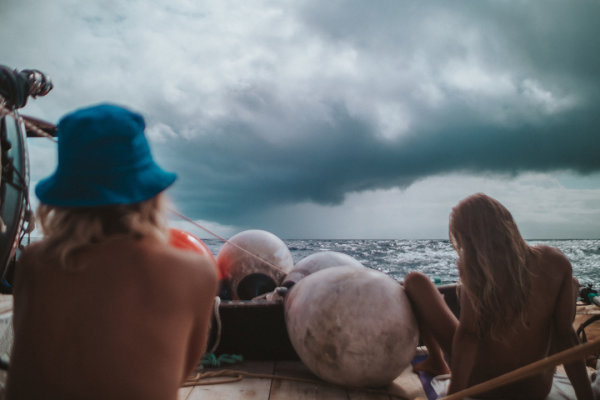
"I thought I was going to die on this trip. I was very certain of that."
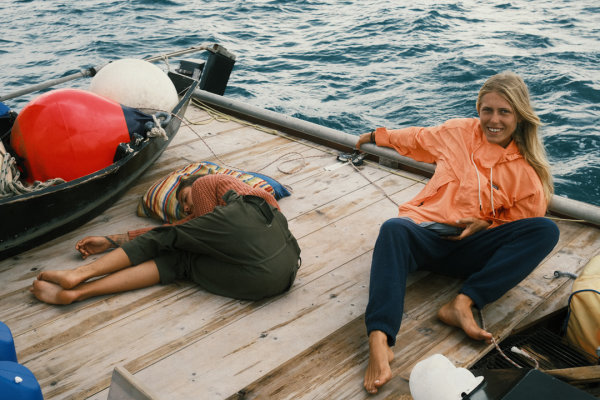
When the pandemic hit, dreams of going anywhere came to a screeching halt worldwide, but it gave Weltzien and Heilmann more time to plan. Finally, in February of 2021, Weltzien took Mara Noka out of the water and into a boatyard in St. Augustine, Florida, where her grandmother lives. Heilmann joined her four months later, and they planned to repair Mara Noka and set sail in a few weeks.
In actuality, the repairs took a full year. With no prior experience in shipbuilding besides Weltzien's knowledge of mixing epoxy, the pair trialed and errored their way through the process, documenting it through photos and reels on the Women and the Wind Instagram page . Friends and family visited to help and offer advice, and one experienced shipbuilder shared his expertise, making occasional appearances to offer advice, sometimes sage, like "listen to the boat." As they deconstructed the boat, they began to understand its structure, and rebuilt from there.
After a year of sanding, sawing, painting, and gluing in the hot Florida sun, in May 2022, Mara Noka was finally ready for the water, complete with a fresh coat of paint and a hand-carved nameplate on a repurposed blank of original Panamanian sour cedar decking. At the end of the month, Mara Noka , Weltzien, and Heilmann sailed from St. Augustine to Beaufort, North Carolina, to prepare for their final departure and to pick up their third crew member, photographer and filmmaker Alizé Jireh.
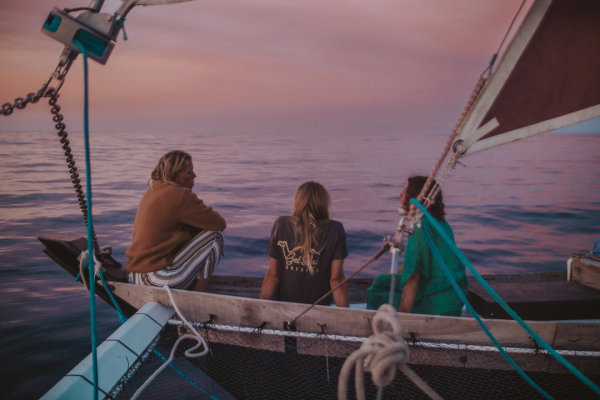
All while Weltzien and Heilmann were remaking Mara Noka , Jireh was keeping up over Instagram, and she became enchanted by the two women restoring a 50-year-old catamaran by hand. Born and raised in the Dominican Republic, she too had spent her childhood around the water and had vivid dreams of sailing. At 16, she started shooting documentary photo work and started traveling with it, eventually connecting with Weltzien while working at a production company in South Africa. The two stayed in contact, and during a trip to St. Augustine in 2021, Weltzien invited her to the boatyard to check out the progress on Mara Noka . Jireh was smitten with the whole operation. Half a year later, Weltzien sent her a message asking if she'd not only like to come along for the voyage, but also capture the experience for a planned documentary. With no prior sailing experience save those childhood dreams, Jireh responded with a resounding yes. "For me, it was no question about it," she says.
With Mara Noka repaired and Jireh on board, the small crew spent most of the early summer waiting to set sail and growing accustomed to the boat, and each other. For Weltzien, who had been happily sailing solo on Mara Noka for years, adjusting to traveling with others would be one of the most challenging aspects of the journey ahead. "I'm a solo sailor," Weltzien explains. "So to sail with people, I needed a purpose. And the purpose is to spread this message of 'if we can do anything, you can do anything.'" Although Heilmann and Jireh were equally dedicated to spreading their intended message, simply surviving the trip proved the tallest hurdle. "I thought that it would be my last time on earth," Jireh says. "I thought I was going to die on this trip. I was very certain of that."
"To sail with people, I needed a purpose. And the purpose is to spread this message of 'if we can do anything, you can do anything.'"
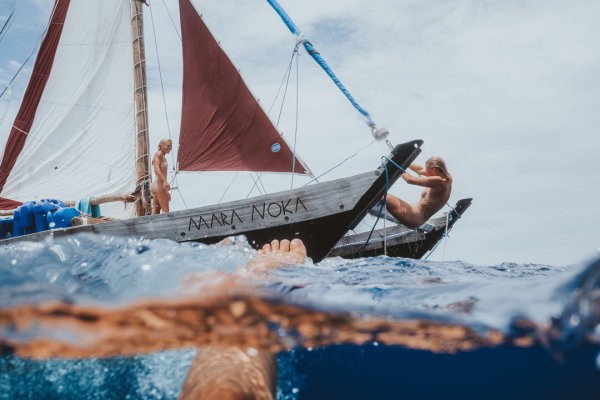
On June 27, 2022, Mara Noka officially set sail. For the next 30 days, the women went without technology, the only connection to the outside world via a satellite phone and a friend, who posted updates to Instagram on behalf of the crew. Even Jireh, who kept her camera rolling for the better part of the voyage, waited until landfall to review more than 100 hours of footage captured during the trip. For 30 days, it was just Weltzien, Heilmann, Jireh, Mara Noka , and the sea.
In the beginning, the ocean welcomed them with calm conditions, but still, each crew member battled personal challenges. Jireh fell seasick almost immediately and remained so for two weeks. Heilmann tested positive for COVID just a few days in. And Weltzien was navigating living with two inexperienced sailors on a boat and in an ocean that had previously brought her seclusion and peace.
The women adjusted to their new reality slowly. "I feel like we didn't talk much for those first two weeks," Heilmann says. "We were all in our little zone." They remained distant throughout the beginning of the journey, in part as a natural reaction to a new lifestyle, and then later they were forced to due to two weeks of bad weather. But there were moments of connection, too. They shared all their meals, a ritual that remained with them through the duration of the voyage. "One thing I think we always did together—except for during the peak of the storm when [Heilmann and Jireh] were my prisoners locked below in the dungeon—was eat together," Weltzien explains.
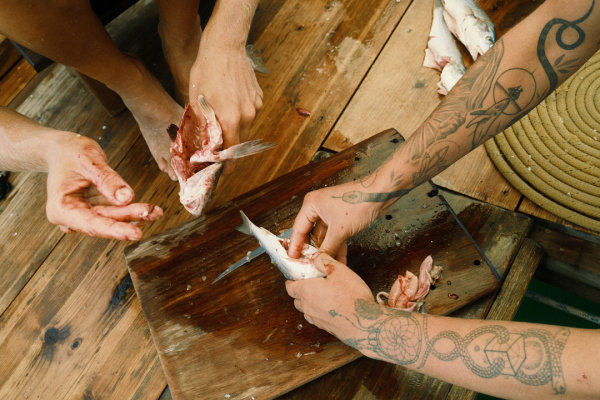
On the seventh day, the winds started to pick up and were followed by weeks of rain, 10-20 foot waves, torn sails, and gear tossed overboard. The three women rotated between sleepless nights in water-soaked beds, sticky and wet from the constant saltwater leaking through the ½-inch plywood into their sleeping quarters. Weltzien was often busy manning the boat in the swell, while Heilmann and Jireh rotated between helping with tasks on board and taking shelter in the cabin below, intimated by the full force of the weather.
Throughout it all, Jireh kept her Panasonic GH 5 camera rolling in 4K (between taking breaks to throw up). Her equipment survived the trip, but barely. "That shit dropped so many times," she says. "The screen stopped working." Both Weltzien and Heilmann were impressed with Jireh's abilities to create in an environment that was literally shifting below her feet. "It's so impressive having seen the other side," Heilmann says. "Seeing her with her camera, throwing up." To the crew, the camera started to develop a personality of its own, an electronic Wilson to their collective Tom Hanks.
"Being a tiny little speck of a boat in the middle of the ocean, seeing trash every day makes you realize that the trash is absolutely everywhere."
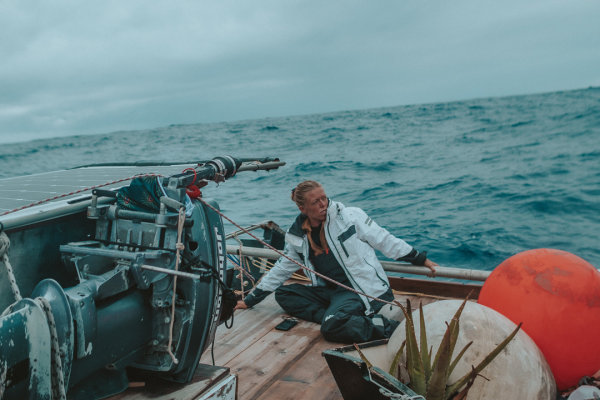
Another constant was the trash they saw in the water. Even out to sea, pieces of plastic would float by every day. Between collecting what they could and their own gear lost during storms, it was hard not to feel overwhelmed by the sheer amount going into and coming out of the sea. "Being a tiny little speck of a boat in the middle of the ocean, seeing trash every day makes you realize that the trash is absolutely everywhere," Weltzien says. They did what they could before, during, and after the voyage, fishing trash out of the ocean and participating in beach clean-ups when on land. "You just have to focus on one solution to the problem at a time," says Heilmann.
On their 19th day at sea, just over halfway through the voyage, the sun reappeared with a small swell and light winds. To celebrate, the crew broke out a bottle of red and their lingerie, a ritual they had planned before setting sail. Buoyed by the shifting seas, amidst clothing and blankets hung to dry, they looked ahead to the remainder of the voyage in good spirits.
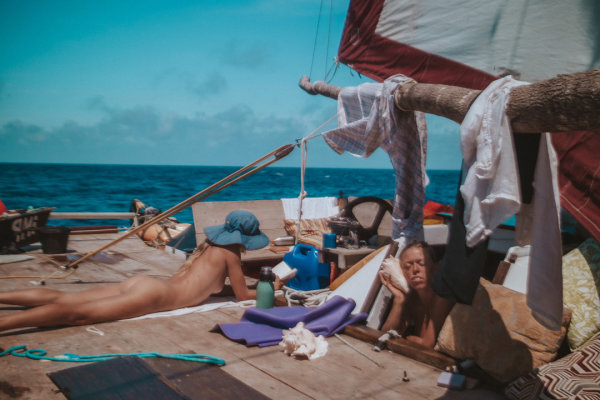
And the ocean seemed to reward them for surviving those initial trials; the remaining 10 days held with good weather, and after surviving the turbulent seas together, they experienced its bounty. They talked more, slept on the deck under the night skies, listened to music, read, journaled, and above all else, indulged in the vastness of their surroundings and the lessons of life on the water. Dolphins, whales, and seabirds paid visits. Heilmann caught her first fish, a mahi-mahi, and spent two days crafting a pirate flag emblazoned with a skeleton mermaid . Weltzien moved back to her normal sleeping quarters from the 12-inch wide bench in the galley she'd been using, and Jireh finally managed to keep food down.
One day out from landfall, all three women anticipated their arrival with a flood of emotions. "I hate arriving," Weltzien says. "It's exciting. It's great, it's beautiful, but it's just like it's your bubble bursting. It's your reality that you thought was real for so long. Just poof." During their month at sea, the boat and their life aboard it had been a departure from the burdens of modern living, a gateway to complete symbiosis with nature.
Yes, certain parts of the voyage had been extremely challenging, but they had all consciously agreed to the perils the Atlantic might present. Life at sea was expansive and vast, and their lifestyle reflected the same. Reaching land, where rigid thoughts, schedules, and structures rule life suddenly seemed more daunting than 15-foot waves. "Everything has to be explained in words that are somehow not enough to explain what you felt," Heilmann shares. "It's very overwhelming."

On the night of July 25, 2022, cell phones buzzing with incoming messages from the past month, Mara Noka cruised past other moored boats and dropped anchor in a harbor off Flores, an island in Portugal's Azores archipelago. The voyage was complete.
For the next month, the crew debriefed while sailing around the Azores together, and waited for the right conditions to deliver Heilmann and Jireh to their departing flights. After goodbyes, Weltzien sailed by herself to Brazil, a crossing that lasted 43 days, realizing along the way that she missed their company.
Today, the three women are spread between Brazil, the Canary Islands, and the US, but led by Jireh, they're editing and producing the Women and the Wind documentary . They plan to overlay Jireh's ethereal footage with journal entries from the trip, and they've also set up a Kickstarter to help meet production costs .
Weltzien, Heilmann, and Jireh are still processing the voyage. They share what they can put into words about how it changed them. "I feel a lot of little things that maybe mattered before, I really don't think they matter at all," Heilmann explains "I think I've never done anything that long with so many uncertainties and so many reasons that you shouldn't. And it feels really powerful."
SUPPORT THE KICKSTARTER
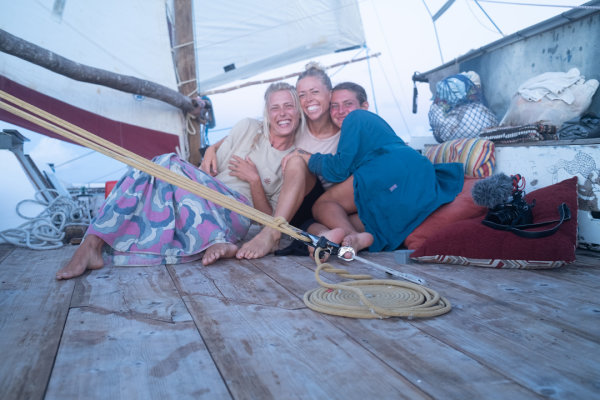
For another ocean-lover making waves, read our Q&A with surfer and photo-journalist Gabriella Angotti-Jones on her new book 'I just Wanna Surf' .
Published 02-28-2023
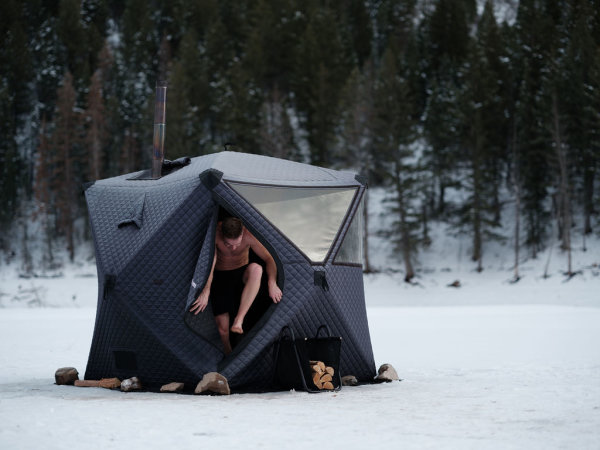
A peek into the steamy world of portable sauna tents to uncover how they work and why they are just so hot right now

Head to the high mountain valley to experience summer's best adventures in Jackson Hole, Wyoming

A conversation with film director David Mesfin on Black surfing, shifting cultures, and Africa's unrecognized role in surf history

A conversation with Christina Lustenberger, Jim Morrison, and Chantel Astorga on what it took to climb and ski the 20,623-foot tall Great Trango Tower

Drawing inspiration from an artistic dynasty and his home region of Chester County, Steindl reflects on his work upon debuting his first zine

From Central Park classics to Brooklyn climbing gyms (and the Gunks), we break down all you need to know about climbing in America’s largest city

Gallery Mode
Yachting World
- Digital Edition

What’s the right yacht for an Atlantic crossing? The one you’ve got now
- Elaine Bunting
- May 20, 2015
What sort of yacht do you need to sail across the Atlantic? There’s no black art, says Elaine Bunting, you just need a bit of preparation

Numerically, the most common yachts for sailing across the Atlantic are ordinary production cruisers with standard kit, usually with upgrades of safety and power generation equipment. The happy truth is there’s no black art to sailing 3,000 miles downwind; the toughest part can be getting across the Bay of Biscay.
So whatever boat you have right now, the chances are that she’ll be fine for an Atlantic crossing with a bit of extra preparation. You don’t have to let waiting for the ‘right’ boat put you off going.
However, this doesn’t apply so much if you intend to complete an Atlantic circuit and sail from the Caribbean to Europe . The return route can be very tough, with a real chance of rough windward work, and a yacht that is wonderfully comfortable and spacious at anchor can slam and be very uncomfortable on the way back. Shipping back or delivery are both alternative options.
I’ve found that skippers tend to focus on equipment that adds comfort, but also complication: watermakers, generators, comms equipment. All are undoubtedly useful, but remember that every additional item adds complication, spares and service cost/time.

Apart from a sound boat, all you really need is water, food, fuel and a (paper) chart of ‘North Atlantic, Southern Part’.
Whatever else you do, don’t let those extras distract you from ensuring the integrity of the rig (including the boom and gooseneck fittings), rudder and hull. These are paramount. Rudders, in particular, are subjected to very high side loads in big following seas. I’ve seen people about to set off across the Atlantic on boats that were sporting the latest luxury kit, from ice cream makers to air conditioning, but with split pins not bent back or a clevis pin working out.
What sails are best?
The simple answer is reasonably recent, quality sails that aren’t liable to break. However expensive, good sails are worth every penny. As to what combination is best on a long downwind passage, that’s a complicated and potentially long-winded debate. Let’s just say that, for the average family crew, a smart crossing is all about consistent speed, 24 hours a day. The key is not to have downtime.

There is absolutely no need to sail hot angles downwind unless you are sailing to polars on a high-performance design. A spinnaker or code sail is great in lighter winds, but in stronger winds you will need several crew on watch at a time and if you blow the sail in a squall or a sudden reload it will be a costly choice.
There is nothing wrong with the old ‘barn doors’ arrangement of mainsail and poled-out genoa. Sure, it’s unflashy and unheroic, but it’s also easy, trouble-free and you’ll trot along in any conditions with minimal drop in speed for the occasional gybe. Just keep an eye out for chafe and be sure to set up a preventer on the boom and a foreguy topping lift and downhaul when poling out the headsail, so you can furl in quickly when that night-time squall hits (which it will).
Power planning
However much power you expect to use on an ocean crossing, you will need more. Nav lights, radar, radio scheds, autopilot, watermaker, fridge, freezer, computer, fans – you name it, they all add up. Last year, when we carried out our annual survey of ARC skippers , we found that yachts of between 46ft and 55ft had a battery capacity, on average, of 700ah, rising to 1,000ah for yachts over 56ft.
Since the design life for marine batteries is five years, it makes sense to set off with new batteries – it’s easier and may be cheaper than replacing them later. A majority of people in our survey had an extra house or domestic battery bank and one or two had boosted the battery used for their windlass.
Interestingly, when we asked about the power equation again in our follow-up survey a few months later , numerous skippers said that they had increased battery capacity yet again or planned to do so in future.

A water generator could be a useful addition
Rather than adding to machinery with a diesel generator, it’s worth looking at wind generators, solar panels and the Watt & Sea or Sea-Gen water turbines . These alternative power generation sources have advanced a lot in recent years. A larger alternator may be worth fitting too, and if only one is fitted to the engine, carry a spare.
Be prepared for gear failure
Be prepared for key equipment to fail because sooner or later it probably will. If it’s gear you normally rely on, like an autopilot or watermaker, have a contingency or a workable plan to do without. Of all the gear problems that give most stress and trouble, the most pressing is autopilot failure. That will start to put a small crew under strain by robbing everyone of rest time.
For the same reason, it’s a good idea to make sure most or all of your crew are decent helmsmen downwind in following seas. If not, spend some time on passage tutoring them.
If you enjoyed this….
Yachting World is the foremost international magazine for bluewater cruisers and offshore sailors. Every month we have practical features to help you plan and prepare to realise your sailing dreams. Build your knowledge month by month with a subscription delivered to your door – and at a discount to the cover price. S ee our latest offers now.

IMAGES
VIDEO
COMMENTS
Before the time of ocean liners and airplanes, crossing the Atlantic used to be a great adventure that took a long time to complete. Nowadays, it's very ... Sailing west and using the tradewinds is perfect on a catamaran, the sail will be faster and more comfortable than a monohull of the same size. Looking at the 2019 ARC (Atlantic Rally for ...
Atlantic Crossing: Sailboat or Catamaran. The vastness of the Atlantic Ocean tests crews' sailing skills and endurance, whether they choose to ply the waves aboard a traditional sailboat or a modern catamaran. Both vessels have advantages, offering completely different sailing experiences. Sailing boat: strong emotions and contact with the sea.
Seeing this as a great chance to sail a purpose-built 50-foot offshore cruising catamaran to learn how it performed on an ocean passage in the many conditions we were sure to encounter on a 2,800-nautical-mile Atlantic crossing, we accepted the offer. Paul investigated a noise at the masthead; while the view was outstanding, he found the motion ...
Traveling across the Atlantic by catamaran will take anywhere between 21 and 31 days. This can be longer or shorter depending on the speed of the catamaran and the number of hours you sail a day. Should you decide to cross the ocean by catamaran, be sure that you have the equipment and skills for such a voyage. Hire a crew if you need to, or at ...
Multihulls are making their mark on tradewinds sailing. Elaine Bunting reports from the 2019 Atlantic Rally for Cruisers. A catamaran on the ARC rally reefed for an approaching squall, as seen ...
The duration of crossing the Atlantic by catamarans varies according to weather conditions, vessel speed, and route. The journey may take approximately 2-4 weeks with an average speed of 9-10 knots. However, little or no wind support during several days may cause an extension for a few days in travel.
Just keep an eye out for chafe, and be sure to set up a preventer on the boom and a foreguy topping lift and downhaul when poling out the headsail so you can furl in quickly when that night-time ...
Weather is a large part of any Atlantic crossing: deciding when to go, which route to follow and the sails to carry. The main consideration is to avoid the hurricane season from June to November ...
Multihulls: Crossing the Atlantic Ocean on a multihull sailboat, which includes catamarans and trimarans, is becoming increasingly popular due to their unique advantages and capabilities. Multihulls have multiple hulls, which offer benefits in terms of stability, speed, and comfort, as well as much mroe deck space. Tall Ship: Steeped in history and romance, tall ships evoke the nostalgia of a ...
A 35-footer might take 25-28 days to sail across the Atlantic from the Canaries to the West Indies. Obviously, the longer and faster your boat is, the more stowage and water tankage you will have for less time at sea. You might also ask yourself which parts of the adventure are the most valuable to you.
The best yachts for a transatlantic crossing. Neel 51. Outremer 5X. Hallberg-Rassy 57. There are many yachts which are suitable for a transatlantic passage. Some will be less expensive, some will be more comfortable, faster, or better suited to you, your experience, and your budget.
Aug 2, 2017. Original: Jul 8, 2014. When cruising sailors talk about crossing the Atlantic Ocean, there are a few things they're all sure to mention: they ate, they slept, they sailed. But in many ways, the similarities end there, and the individual stories unfold with their own cast of characters, each pledging the ancient fraternity of the ...
In November of 2022, I joined the crew of the Lagoon 42 catamaran Games Maker II during the westbound Atlantic crossing from Gran Canaria to St Lucia. The boat was part of the 2022 Atlantic Rally for Cruisers (ARC). The crew included the British boat owners couple Tony and Lel and their old friend Joz from Australia.
An Atlantic-crossing suitable catamaran measures around 40 to 50 feet (12 to 15 meters) long, which is size is ideal for long-distance travel with a small crew. Choosing the right size for an ocean-crossing cat is important. A large-enough sailboat provides adequate room in the living spaces and can accommodate cooking spaces, separate dining ...
If your catamaran's home port is in the Mediterranean, you will start by discovering the Balearics before passing the first gate: Gibraltar. If you are leaving Europe from the Atlantic coast, a first crossing awaits you, with the dreaded Bay of Biscay and its legendary (and feared) gales.
James Anderson agrees: "Carry a spinnaker and don't be afraid to fly it. It's the best downwind sail there is.". Make sure the preventer is taken from the end of the boom, preferably led ...
There are also sailing cargo Atlantic crossing possibilities out there. ' Tres Hombres ' is a 32 metres Schooner transporting traditional goods like rum and chocolate between the Caribbean and Europe. Timbercoast is a 1920 built 43.5m Schooner that transports goods like coffee and gin.
Greta Thunberg made waves — both literally and figuratively — when she opted to cross the Atlantic on a catamaran. Her crossing inspired many others to do the same — but such a feat requires a bit of preparation. Get a Bit of Training. A lot of things can happen in the ocean. Most of the time, you can't rely on anybody else for help.
We sailed through the Atlantic Ocean from Hampton, VA in the Chesapeake to the British Virgin Islands in the Caribbean on our Leopard 45 Sailing Catamaran. W...
In 2022 three women crossed the Atlantic Ocean on a wooden catamaran to document plastic pollution and find adventure, here's how. Field Mag. Cabins Gear Photography Shop Newsletters About. Search Women and the Wind: Crossing the Atlantic in a 50-Year-Old Catamaran In 2022 three women crossed the Atlantic Ocean on a wooden catamaran to document ...
Join us during this 13 days and nights passage sailing across the Atlantic Ocean in our sailing catamaran Lagoon 450S in family from Cap Verde islands to Mar...
It took us 16.5 days to cross the Atlantic Ocean from Las Palmas Gran Canaria to St. Lucia! It was just our family, the crew, the boat, water, and sky as far...
Last year, when we carried out our annual survey of ARC skippers, we found that yachts of between 46ft and 55ft had a battery capacity, on average, of 700ah, rising to 1,000ah for yachts over 56ft ...
Crossword Puzzle Answers . Search for answers to a complete crossword puzzle using a crossword clue, publication, or puzzle title. Type a clue in the text box and click "Search Clues" or type the name of a publication or puzzle name in the text box and click "Search Puzzles" to generate a list of results.
Ohio-based Edwards completed Atlantic Crossing's first phase in 2022. It includes a 261-unit apartment building and another office building with retail space. The project will have a combined ...